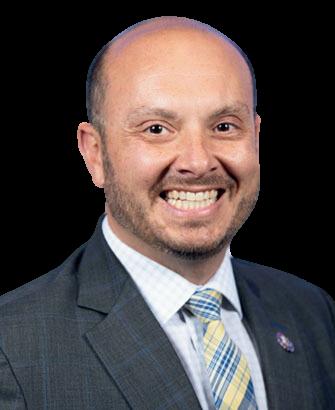



TUESDAY NOV. 5TH







TUESDAY NOV. 5TH


By Matt Meduri
To endcap what has been one of the most surreal election cycles that most have not seen in their lifetimes, the Suffolk County Republican Party hosted their annual Hangar Rally at Brookhaven’s Calabro Airport in Shirley to help deliver final push as the election cycle comes to a close.
Suffolk GOP Chairman Jesse Garcia (R-Ridge) was joined by a host of elected officials and candidates at Tuesday night’s rally.
“In early voting here in Suffolk County, Republicans and Conservatives have outpaced Democrats by more than 10,000 in just four days to vote for this team,” Garcia told supporters.
Continued on page 8
On Saturday, October 19, Legislator Jim Mazzarella (R-Moriches) joined with volunteers from the Pattersquash Creek Civic Association, the Mastic Beach Creek Defender, Save the Great South Bay, students from William Paca Middle School, and local Boy Scouts for a community cleanup of Pattersquash Creek in Mastic Beach. Before the cleanup kicked off, Legislator Mazzarella presented the Pattersquash Creek Civic and Save the Great South Bay with a Water Quality Protection and Restoration (WQPRP) Grant for $80,155.
will be utilized to remove invasive plant life and replace it with native species within the Pattersquash Creek watershed area. This project will help rejuvenate the health and ecology of the Pattersquash Creek.
This project was the brainchild of Mastic Beach residents Walt Meshenberg and Mike Lovell, who joined forces with Robyn Silvestri, the Executive Director of Save the Great South Bay to spearhead this initiative.
“Kudos to Walt Meshenberg, Mike Lovell and Robyn Silvestri for their commitment to the preservation and restoration of the ecology of Pattersquash Creek,” stated Legislator Mazzarella. “Thank you to County Executive Ed Moriches) and the Suffolk County Department of Economic Development & Planning for their support of this






Spacious



Published by Messenger Papers, Inc.
By Cait Crudden
Assemblyman Joe DeStefano (R-Medford) hosted a special “Women of Distinction” awards ceremony to honor seven exceptional women who have made significant contributions to their communities. The event recognized women from various backgrounds and professions who have demonstrated outstanding leadership, volunteerism, and dedication to making Suffolk County a better place to live.
In his opening remarks, Assemblyman DeStefano expressed his gratitude for the remarkable work these women have done. Also in attendance was State Senator Dean Murray, Legislators Dominick Thorne (R-Patchogue) and Nick Caracappa (C-Selden) and Councilman Michael Loguercio (R-Ridge). DeStefano stated that these women went above and beyond to make a difference in our community. These women help those in need and are community leaders. He went on to thank them for their dedication and inspiration.
Jodi Moran, a passionate advocate for social justice, was recognized for her extensive work with Suffolk County Community College. She has championed arts programs within the Patchogue-Medford School District and volunteers weekly at Almost Home Animal Rescue, working to save and rehabilitate animals in need. Moran’s dedication to both education and animal welfare has made her a vital part of the community.
Nerina Sperl was celebrated for her lifetime of public service. Currently, Sperl serves as the Chief Auditor at the Suffolk County Comptroller’s Office. She is an active member of the Patchogue-Medford Finance Committee and leads a local Girl Scout troop, nurturing the next generation of women leaders. Her long-standing commitment to public service and community involvement is deeply admired.
Linda Piotrowski, a Sergeant in the Suffolk County Police Department’s 6th Precinct, was honored for her work empowering women through free self-defense classes. She also assists women recovering from domestic violence and human trafficking situations, working to provide them with the tools they need to regain control of their lives. Her tireless dedication to ensuring women’s safety has had a profound impact on the community.
April Coppola, the President of the William Floyd
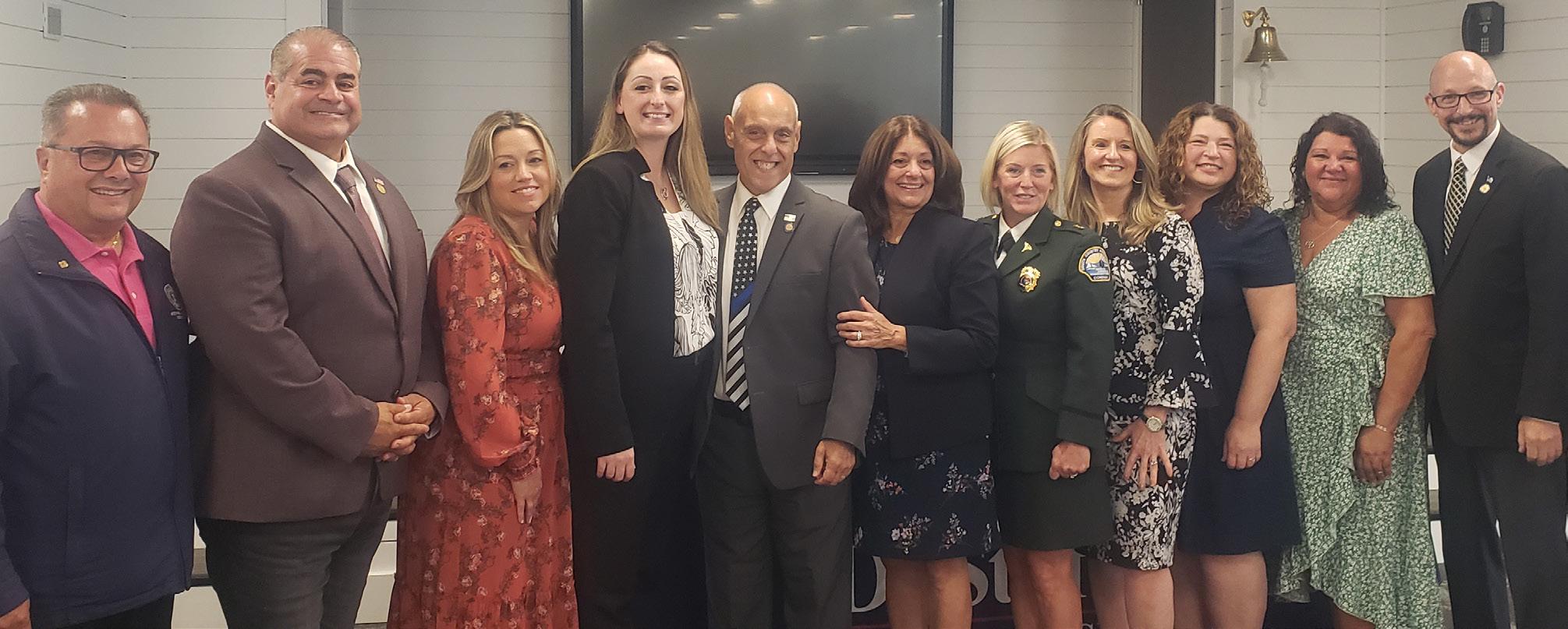
School District, has long been a strong advocate for the arts, music, and sports. Coppola is also active in her local Chamber of Commerce and continuously works to beautify her community. Her leadership and advocacy have helped elevate the importance of arts education and community pride throughout the William Floyd district.
Denise Nostrom was recognized for her success as a financial advisor and her service to the Patchogue-Medford community. As the President of P.O.W.E.R. and owner of Diversified Financial Solutions, Nostrom has helped countless individuals and families navigate their financial futures. She also hosts a weekly radio show, “The Financial Chick,” and assists the Patchogue-Medford School District by providing scholarships to students.
Danielle Paisley, the Director of the Patchogue-Medford Library, was honored for her leadership in opening the Medford Library Branch and re-opening the historic Carnegie Library in Patchogue. She also serves as the Secretary of the Patchogue-Medford Foundation and is an active member of the Rotary Club and Chamber of Commerce. Paisley’s vision and dedication to library services have transformed the community’s access to educational resources.
Amy Thomas, the Assistant Chief of the South Country Ambulance EMS, has been an EMT for twenty-one years

and coordinates CPR and first aid training throughout the community. In addition to her professional duties, Thomas volunteers with two non-profits, offering her time and expertise to those in need. Her commitment to emergency services and community outreach has made her a true role model.
After the ceremony, Assemblyman DeStefano expressed his deep appreciation for the contributions these women have made. “Women of Distinction are the folks who really make a difference in our community. They go out and do the right thing day in and day out without expecting anything in return. They help their neighbors and people they don’t even know just because they have a need, and they have the ability to help”.
Each honoree was presented with an award, and a morning that was filled with heartfelt speeches and a sense of community pride. The event served as a reminder of the importance of recognizing the contributions of women who often work behind the scenes to make their neighborhoods stronger and more vibrant.
The “Women of Distinction” awards ceremony highlighted the remarkable achievements of these seven women, whose leadership, dedication, and compassion have made a lasting impact on Suffolk County.
By Diane Caudullo
Many hands were on deck for the Ronkonkoma Chamber of Commerce to present a giant-sized check for a whopping $10,000 to the American Cancer Association’s Making Strides Against Breast Cancer.
During the presentation, on the steps of the New York Cancer and Blood Center in Lake Ronkonkoma, a few individuals told of their own journeys with and through cancer. One such individual was Suffolk’s very own Sheriff Errol Toulon (D), who has beaten cancer three times.
This generous amount was raised at the annual Ronkonkoma Chamber’s Celebrity Softball event on July 29.
Entered as a second class matter at the Post Office of Smithtown, NY, under act of December 21, 1879. Periodicals postage paid out of Smithtown, NY. This newspaper will not be liable for errors appearing in any advertisement beyond the cost of the space occupied by the error. The opinions expressed in byline articles, letters and columns are those of the author and not necessarily those of Messenger Papers, Inc., its publishers or editors. Pictures submitted for publication remain property of the publisher.
Postmaster: Send address changes to Messenger Papers Inc, P.O. Box 925, Smithtown, NY 11787
www.messengerpapers.com
By Matt Meduri
The Messenger has been covering and forecasting the national elections since the summer. Our presidential forecast showed former President Donald Trump (R-FL) with 235 electoral votes and Vice President Kamala Harris (D-CA) with 225 votes. 270 are needed to win.
This week, we’re shifting a few states as the race has continued to develop.
Arizona (11): Toss Up to Tilts Republican: Trump has held thin but consistent leads in the polls here. While the aggregates show the race is within the margin of error, we think this is one that goes to him just based on the numbers. Joe Biden (D-DE) held a two-point lead in the averages in 2020 and won the state by a thin margin. While Democrats would likely enjoy keeping Arizona in their column, it’s not necessary for Harris’ path to victory. Republicans have surged ahead of 2020 early vote totals, making for another reason that a Trump win in Arizona seems likelier than not.
Connecticut (7): Safe Democrat to Likely Democrat: This is a cautious shift only because of possible swing in New York towards Trump. If economics is a key issueand Trump regularly polls as the preferred candidate on handling this issue - then a wealthy state like Connecticut might deliver a thinner-than-usual margin for Harris. If anything, this shift indicates a “margin watch” on her part.
Delaware (3): Safe Democrat to Likely Democrat: The logic here is similar to Connecticut, but bounded more by economics. More than half of Fortune 500 companies are incorporated in Delaware because of its friendliness towards business. The state was not remotely in play in 2016, yet Delaware swung almost ten points to the right that year. An argument for Trump’s position in handling the economy might see Delaware swing back towards him, especially without native son Biden on the ticket. Like Connecticut, this is also a prohibitive shift to watch for a slip in Harris’ margin. Harris’ plan to greatly increase the tax on unrealized capital gains is not likely to go over well in this pro-business environment.
Georgia (16): Toss Up to Tilts Republican: Trump’s leads here have been just as consistent as they have been in Arizona, but some of the margins are wider. Fundamentally, Georgia is still a red-leaning state, and if Trump emerges with historic levels of black support, it would likely erase Democratic gains in the rapidlyexpanding Atlanta areas. Like Arizona, Georgia is a trophy for Democrats, but not needed to hit 270. Biden’s average lead here was about one point in 2020; Trump has that lead doubled as of press time. A polling miss would likely see a slightly larger margin than that in his favor.
Illinois (19): Safe Democrat to Likely Democrat: Like Delaware and Connecticut, this is another “margin watch” state, simply because if Trump’s appeal in New York is as broad as we think, then it would likely transcend to a state with similar problems. Moreover, a significant shift in the Latino and black populations to Trump would likely push Illinois more towards the right than Democrats would prefer.
Maine (2): Leans Democrat to Tilts Democrat: Maine’s two at-large electoral votes were unusually in play in 2016, so much so that Maine was almost a sleeper upset for Trump. Biden swung it back in his corner in 2020, and what little polling we have shows Harris with decent, yet not insurmountable leads. We think that if enthusiasm for Trump is on 2016-levels, then Maine is absolutely within the margin of error. We’ll still give Harris a slight edge due to the fundamental lean of the state, but Republicans will very likely continue to play here for the coming cycles.
Michigan (15): Toss Up to Tilts Republican: Republicans have not polled as well as Trump has in Michigan in decades, and even though the aggregates find the race to be a complete coin toss, a race that tight is usually one Trump wins.
Nebraska CD-02 (1): Toss Up to Leans Democrat: This sole electoral vote is not a huge site of campaign visits, but in a close election, like 2020, it certainly can be. Neither campaign has been on the ground as much as they have been in 2020, but Harris has decent leads here. Trump
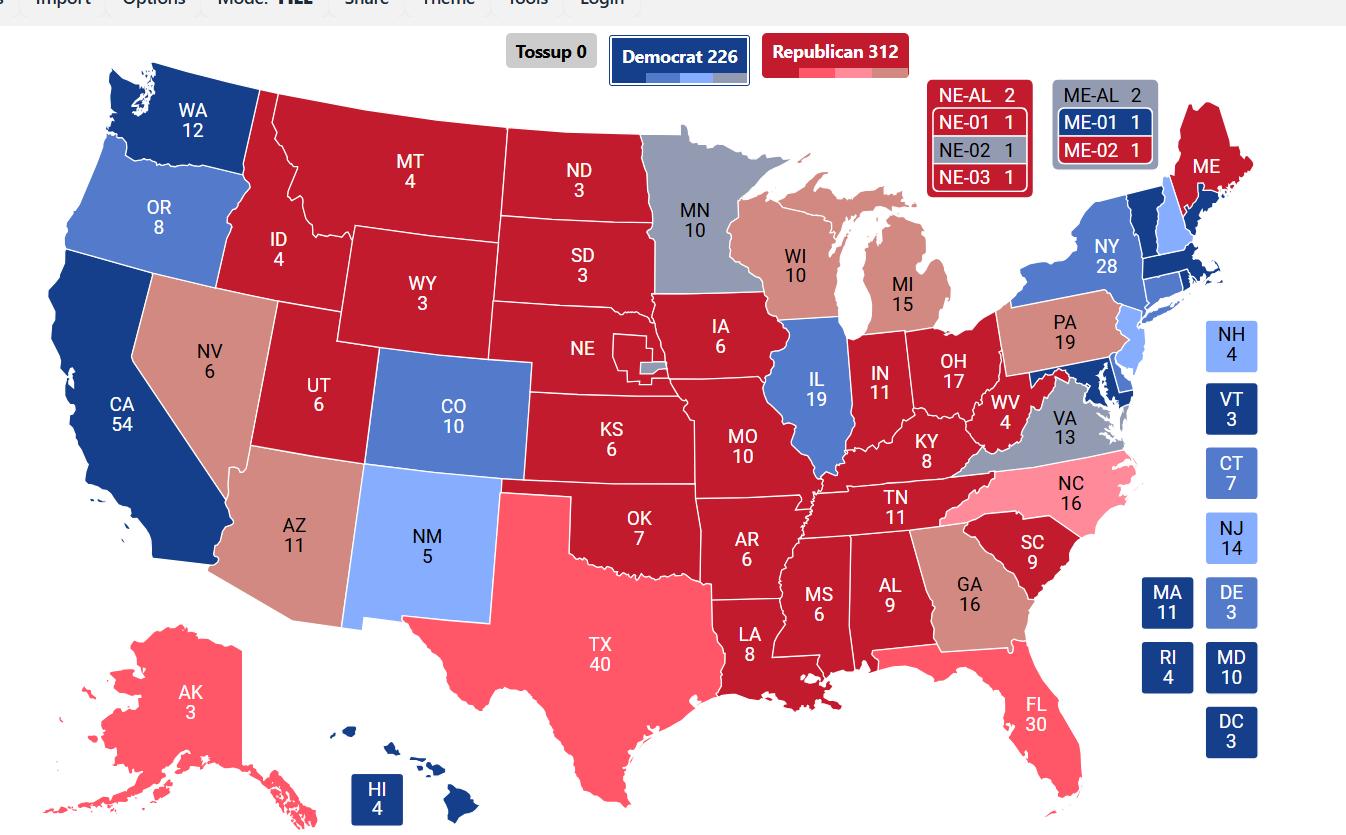
would be wise to avoid spending resources for a sole vote he doesn’t necessarily need. As the Omaha area might drift to the left, it’s not likely to make or break this election.
Nevada (6): Toss Up to Tilts Republican: This is a tough call, mainly because polls in Nevada tend to vastly underestimate Democratic support over the last few cycles. But Trump’s polling among Latino voters, Republicans’ leads in early voting, and our own conversations on the ground in the Silver State make us think Trump has a slight edge in flipping this state red for the first time since 2004.
New Jersey (14): Likely Democrat to Leans Democrat: This call comes after conversations with people on the Trump campaign, who feel very confident about New Jersey. No Republican has won here since 1988, and our logic here is that if Trump led the polls here shortly before Biden’s exit in July, then Harris’ ceiling can’t be that much improved. Polling puts her around low-to-mid doubledigits, which would be a somewhat underwhelming Democratic victory in this otherwise blue state. Trump’s appeal in New York is likely to have residual effects on New Jersey, as a good amount who attended his three Empire State rallies came from just next door. We wouldn’t be surprised to see New Jersey much closer this year than it is in other years.
Pennsylvania (19): Toss Up to Tilts Republican: This is the state that the entire election comes down to for either campaign. Like in Michigan, although it’s a statistically tied race, it’s one where Trump likely prevails. The GOP has opened an early voting lead and the ground game has been bigger here than perhaps in any other state. Republicans have registration advantages in historically blue counties, making us think there’s a good floor of support for the former president.
Virginia (13): Leans Democrat to Tilts Democrat: Like Maine, this is another sleeper target for Trump. Polling after the Biden exit had him leading in the state, and while Harris has had consistent leads, they’re not at the levels we saw in 2020. Trump is making a last-minute play for the state, but unless there’s a significant polling miss, Harris might narrowly walk away with Virginia.
Wisconsin (10): Like the other two Rust Belt states, a statistically tied race is probably one Trump can win. Of those three Midwestern giants, Wisconsin is the state where polls whiffed the worst in both 2016 and 2020. Wisconsin was also much closer than neighboring Michigan in 2020, making us think Trump can flip this state back into his column.
Our final forecast gives Trump a baseline of 312 electoral votes, six more than his 2016 win. This is a forecast, and in the event of a polling miss in either candidate’s favor, it could be a different end result.
If Trump overperforms, he’s likely taking Minnesota,
New Mexico, Maine, Virginia, and possibly New Hampshire and NE-02, for an Electoral College win of 347. Anything north of that seems highly unlikely, but if the campaign’s confidence in New Jersey is warranted, then that would likely be a 361 win for Trump.
If Harris overperforms, she’s likely holding the entire Biden coalition (307 votes) and flipping North Carolina. Her last-minute pull of $2 million worth of ads on the state’s media markets likely signals she’s surrendering this state this cycle.
A realistic best-case scenario for Trump is our forecast: 312 electoral votes. He could repeat his 306 total in 2016 if he were to lose Nevada and win everything else.
A realistic best-case scenario for Harris is 276 or 287, with the difference being Arizona’s 11 votes. We think Georgia is just out of reach for her this cycle, but if she can preserve the status quo, with Arizona being give-or-take, she would narrowly win in the College.
In the Senate, Republicans have the home-field advantage with a map that features practically no seats that Democrats could realistically contest to pad their likely losses. The GOP is highly likely to flip West Virginia and we retain Montana with a “Tilts Republican” rating. Polls show Tim Sheehy (R) steadily ahead of Senator Jon Tester (D). We were thinking of pushing this to a “Leans GOP” rating, but a recording of Sheehy making somewhat apathetic remarks about abortion makes us think this intrinsically libertarian state with an abortion measure on the ballot this year might not go as hard for Sheehy as some observers believe.
Arizona: Tilts Democrat to Leans Democrat: Congressman Ruben Gallego (D, AZ-03) is holding thick and consistent leads against former news anchor and 2022 gubernatorial candidate Kari Lake (R). Even as we think Trump will win the state, voters here seem set on splitting their tickets.
Michigan: Toss Up to Tilts Democrat: As Senate Democrats have run ahead of Harris in the battleground states, Michigan is one that will probably see Congresswoman Elissa Slotkin (D, MI-07) take this open seat. Mike Rogers (R) could flip this in an upset, but it would depend on Trump’s margin of victory in the state. Although we think Trump will carry Michigan, his margin will likely not be much greater than razor-thin, effectively erasing Rogers’ margin for error.
Nebraska: Safe Republican to Likely Republican: Senator Deb Fischer (R) has a relatively quiet profile in the
Published
Senate which is being challenged by Independent Dan Osborn, a Navy Veteran, steamfitter, and former labor union leader. Polling shows Osborn pulling within the margin of error, but many of the polls are sponsored by him. We’re shifting this out of observation of a likely margin slip for Fischer, in addition to the fact that no Democrat is running in this race. Vote-splitting will not be a factor here, likely aiding Osborn’s candidacy. Nebraska is intensely Republican, so we think Fischer will get by, but if Osborn wins, it remains to be seen which party he would caucus with should he earn a six-year term in Washington.
Nevada: Toss Up to Leans Democrat: This race has really gotten away from Sam Brown (R). Although Jacky Rosen (D) hasn’t been the most vocal Senator, our talks with people on the ground in the Silver State make us believe there’s a ticket-splitting aspect in play here, similar to that in Arizona. Polling is also not on Brown’s side, and in a state where Republicans are usually overestimated in the polls, it might mean he’s even more underwater than the polls estimate. It would take a big miss to see him win this seat. It’s possible, but we’re inclined to believe Rosen is a slight favorite for a second term.
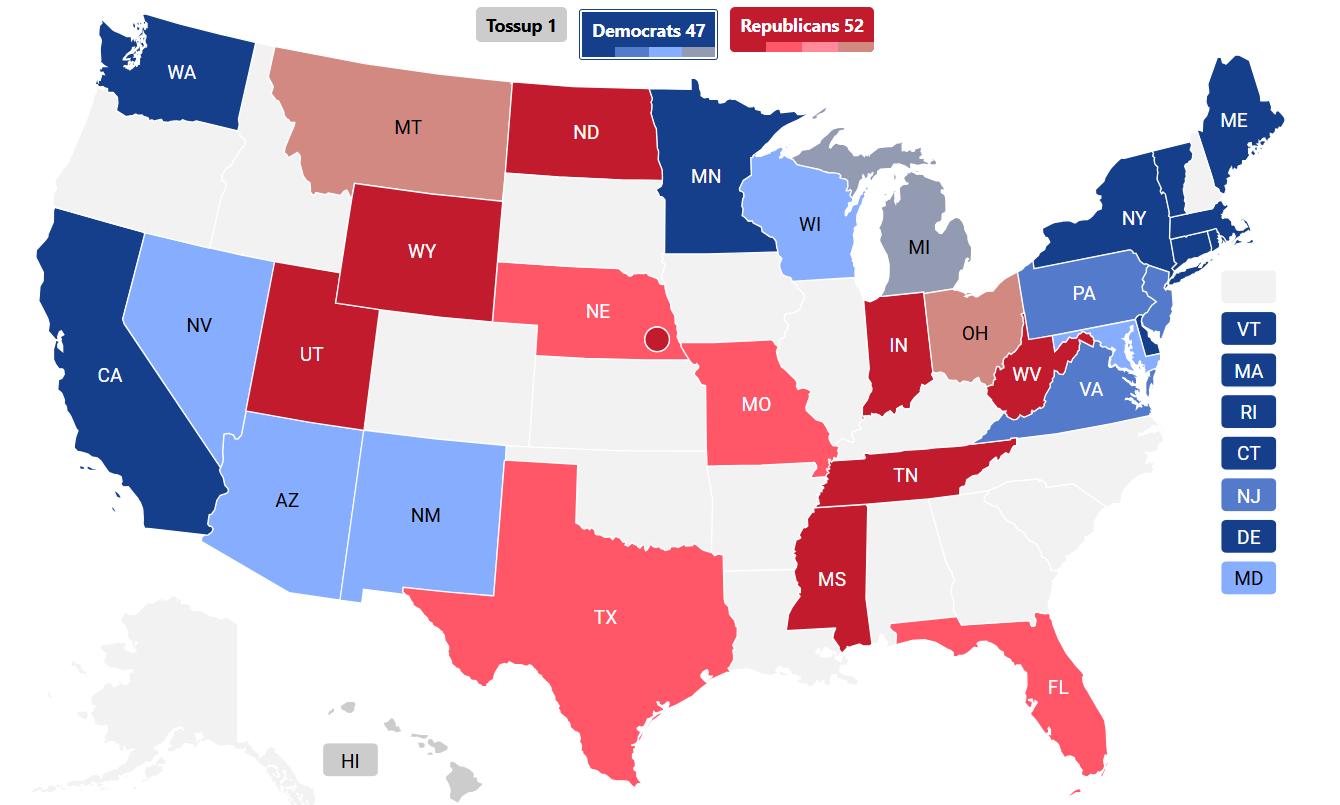
class message will appeal in this part of the state, creating an environment where Eric Sorensen (D, IL-17) narrowly misses a second term. However, this is a race that could go either way.
MI-07: This Lansing-based district was narrowly defended three times by Elissa Slotkin, who is vacating the seat to run for Senate. Tom Barrett (R) was 2022’s nominee, and the half-rematch, open-seat dynamic in a state poised to flip to Trump makes us think he flips this seat.
Ohio: Toss Up to Tilts Republican (Flip): Senator Sherrod Brown (D-OH) is in the fight of his life to retain his Senate seat in a once-quintessential swing state that has raced to the right in the Trump era. We think that Trump is on track to take Ohio by about 12-13 points, which makes for a brutal task in crossover appeal not usually seen in the modern era. Bernie Moreno (R) has caught up to Brown in the polls, marking a stark contrast from the last time Brown ran in 2018. We think the GOP flips this seat. At this point, we’re comfortable with our forecast of 52 seats for the GOP in the Senate. Three flips in West Virginia, Montana, and Ohio seem more likely than not at this point, with the possibility of GOP upsets in Michigan, Wisconsin, and Pennsylvania. We’ll even add New Mexico to that list as an abundance of caution. Democratic targets don’t seem to be panning out, with the GOP holding leads in Florida and Texas. This Senate map hasn’t really expanded like how it did in 2018. On both presidential and senatorial levels, we think Florida votes to the right of Texas.
Republicans have a tenuous 221-seat majority in the lower chamber. In a contest with few underdogs, we believe Republicans have the advantage in retaining their majority and possibly expanding it.
AK-AL: Alaska’s at-large district is a tough one to call, mainly because of Mary Peltola’s (D) incumbency advantage. But polls have shown Nick Begich III (R) catching her in a rematch, and without another Republican candidate spoiling the ballot, we think this is a narrow GOP flip. On the other hand, we wouldn’t be surprised to see Peltola hang on.
MI-08: The areas of Saginaw, Flint, Midland, and Bay City were key to Trump’s 2016 upset here, and these cities, once solidly Democratic, have raced to the right in the last eight years. The seat is open, making us believe the time is ripe as ever for the GOP to flip this seat.
NM-02: The sprawling Second District of New Mexico was gerrymandered to be more Democratic-leaning. Yvette Herrell (R) flipped this seat in 2020, but lost it in 2022. She’s running a rematch against incumbent Gabe Vasquez (D). While polling gives Vasquez the edge, we think there’s a shift among Latino voters that would give way to a Herrell win in NM-02.
NC-06: Republicans drew a gerrymander so hard, Democrats chose not to contest this seat.
NC-13: Carefully drawn around the outskirts of Raleigh-Durham, Wiley Nickel (D) chose not to seek re-
PA-08: Matt Cartwright (D) has defied odds before, both with Trump on and off the ballot. But the machine that the GOP has assembled in Pennsylvania might be too much for Cartwright to overcome in this Scranton-Wilkes Barre-based district. Republicans also now lead in registration in Luzerne County, a historically working-class Democratic county.
AL-02: Redistricting mandated a second black-majority district in Alabama. Polls show a surprisingly tight race, but one that Democrats are likely to pick up.
AZ-01: The sprawling Phoenix suburbs look likely to swallow Dave Schweikert (R) this year, as he only narrowly survived in 2022. If Trump’s coattails are large enough, it could insulate him from defeat, but we think there’s a lot of ticket-splitting happening here and we don’t assume Schweikert is on the good end of it.
NE-02: Don Bacon (R) has survived tough election after tough election, but usually when the polling is more evenhanded. This time, Tony Vargas (D) has led almost every survey, and that, coupled with Harris’ apparent strength in the Omaha-based district, makes us think Bacon is already underwater.
NY-22: Brandon Williams (R) is a freshman Congressman filling the shoes of a well-known maverick who survived the 2018 midterms. Democrats’ mid-decade redistricting shuffle made this Syracuse-based seat slightly bluer, which makes us think, in this polarizing time, that Williams might not make it out of this one. He could certainly win, but fundamentals make us assume otherwise.
LA-06: Redistricting mandated a second black-majority district in Louisiana. Democrats are a heavy favorite to flip this seat.
These seats are on what we call “Upset Alert,” in that we could easily be surprised by how far the pendulum can swing in House races, especially when they depend almost entirely on presidential coattails. We think both parties win these seats as they appear, but we contend that some are simply too close to call and others are likely to rely on other factors.

Republican Upset Alert Seats: AZ-06, CA-13, IA-03, MI-10, NY-04, NY17, NY-19, OR-05
Democrat Upset Alert Seats: CA-09, CO-08, CT-05, FL-09, IN-01, ME02, MD-06, NV-03, NY-18, NC-01, OH09, OR-06, PA-07, TX-34, VA-07, WA-03
Our final toss up on the gubernatorial map was New Hampshire, which we think will go to Kelly Ayotte (R) by a narrow margin. The race is essentially locked up for Josh Stein (D) in North Carolina, while we’re watching for upsets in Washington. Some close polls in Indiana warrant a “Likely R” rating, but the last-minute narrowing of the gap is unlikely to result in an Election Day upset.
CA-47: Scott Baugh (R) ran against Katie Porter (D) here and narrowly lost in 2022. Now, he’s back for the open seat. Polls have been tight, but with consistent Baugh leads.
IL-17: This carefully-gerrymandered district takes in Rockford, the Iowa suburbs of Moline and Rock Island, and heads down to Peoria and Bloomington. The old version of the district is one that Trump carried. We think his working-
election. GOP is favored to flip.
NC-14: Another gerrymander, this time around Charlotte, that saw one-term Jeff Jackson (D) quit the race early.
OH-13: The areas of Akron and North Canton were one the bread and butter of Democrats’ Ohio machine. Now, much of that area is Trump country. We think the GOP picks off this northeastern Ohio district.
These are simply predictions based on what we’re seeing and what information is readily available to us. We enjoy bringing this otherwise national content to our readers on the local level, and we look forward to doing the autopsy on the election, regardless of how accurate our forecast is or is not.
It seems more common now than ever that voters are increasingly displeased with the choices they have for political office. Some chalk it up to the binary two-party system we have in the United States, others simply say that political tensions have risen so sharply that we shouldn’t expect less from the major party’s contenders.
There’s stock in both of these reasons, but we’ll state, just days before the pivotal 2024 elections, that there has never been a time in U.S. political history that either party had the “perfect” candidate.
Politicians and elected officials are people too. They have their own baggage, ideals, and histories. As long as there’s not a conga line of skeletons emerging from these closets, we would say most people running for office fit this description.
Some might take issue with rhetoric, personality, and/or charisma, or lack thereof. These aren’t bad priorities to have when making decisions at the ballot box, but it’s important to note just how important these aspects of candidates are in the grand scheme of things.
That leads us to our editorial message to close this historic campaign: a vote is not a valentine.
This Tuesday, consider policy to be your top concern. Were you better off now than you were four years ago, or two years in terms of State government? Do you find things to be just fine compared to how they were just as long ago? Are you somewhat mixed in that regard?
Your answers are yours. The validity of each is too much for us to analyze, but we assume that most voters’ reasons for their choices carry at least some degree of validity. We’re a big country, a big state, and a big county. There’s bound to be a stark contrast in opinions somewhere along the way.
But we believe that our electoral process has been hijacked by a sensationalist conglomerate of mainstream media and unelected players looking to jump in and scramble the airwaves. The public has received an onslaught of messaging of “decency” over the last several years, with no real definition provided. The powers that be seem to think that invoking these vague concepts, as nice as they are, is enough for the vast
majority of Americans in this highly unique and complex country to decide who should be the leader of the free world for the next four years.
You don’t have to be in love with the person you plan on electing. You don’t have to agree with every aspect of his or her platform and you don’t have to commit your life to supporting this person, his or her party, or everything he or she stands for.
But you do have to be aware of the reason you’re planning on hitting your local polling place. We don’t hold more authority than anyone else to tell you what reasons you should have squared away in order to cast a ballot this year. However, we do think it is incumbent upon the electorate to not only research their candidates and policies of choice, but to research their own perceptions of the political ballgame being played and to organize their thoughts and emotions ahead of the vote. Spite votes - or withholding a vote due to spite - or sitting an election out entirely might be reasons to cast a ballot or not, but are they valid reasons? Are they rooted in the classical principle of putting policy in office, not necessarily a face and name?
Is a candidate on your ballot bombastic, annoying, and unconventional, but would result in what you believe to be sound policy with which you could live comfortably? Vote for that candidate. Is your candidate appealing on the outside but you don’t have a decent grasp of the policy? Do some more research. Is your candidate perfect in every possible way? We know this answer can’t possibly be in the affirmative, but if that’s what you actually think, then come to terms with his or her humanism and do some more research.
This November, we ask our readers to perform a good, long autopsy on the last four (or two) years and we ask our readers to perform a good analysis of their own priorities and reasons for voting.
Policy is key. You don’t have to take your candidate to prom, but it is your responsibility to be sure of who you are putting into office, and that begins with shelving the dissonance routinely provided by white noise of mainstream and social media and consulting the best possible barometer for the nation’s political moods: Yourself.
It’s hard to believe that a state like New York once routinely bet on a split form of government every two years. In fact, Republicans controlled the State Senate from 1966 until 2009. Republicans would then control the upper chamber again from 2011 until 2019, with some of those years complicated by the leadership crisis and “parliamentary coup” marking the beginning of the last decade. Republicans governed with a coalition majority.
But it wasn’t until 2019 that Democrats would fully consolidate control with a trifecta in New York, controlling both chambers of the legislature and the governor’s office. Since then, with two more elections that allowed Democrats to retain control of New York entirely, we’ve also had two governors who haven’t done their party justice.
Since Democrats formed a trifecta just five years ago, the State budget has grown by a whopping $78 billion, our legislators are the most well-compensated in the country, and life in New York hasn’t been made easier by any stretch of the imagination, clearly evidenced by the state’s population hemorrhage and an apparent lack of initiative from the progressive wing of Albany.
Even common sense Democrats have a difficult time pushing their legislation through the halls of the capital, as the progressive wing has completely taken over the discourse. Republican incumbents have told us during our campaign interviews that there is no giveand-take in Albany, and Assemblyman Keith Brown (R-Northport) said it’s “disappointing.”
Governor Kathy Hochul (D) hasn’t done her or her party any favors either. While personable enough, Hochul has not demonstrated a backbone that her predecessor Andrew Cuomo (D) had, despite being disliked for being a “bully,” according to those who have worked closely with him. Craig Herskowitz (D-Northport), the opponent of Senator Mario Mattera (R-St. James), who worked closely with Cuomo, said this himself in our interview with him.
Moreover, Hochul has repeatedly demonstrated her inability, or perhaps her unwillingness, to throw elbows and get some items that she wants enacted. Just before Christmas 2022, the legislature voted for pay raises for themselves that made them the
most well-compensated state body in the country, while leveraging that deal for nothing in return. It makes sense why the legislature, especially the progressive faction of the Democratic caucus, is unwilling to give her some wins that would largely help her legacy, such as repealing the most problematic aspects of bail reform.
Overall, Democrats have not made New York great again and Hochul, try as she might, can’t get anywhere with members of a legislature unwilling to work with their executive.
This November, we hope that Republicans can crack the supermajorities in both chambers. The GOP needs ten seats to flip the Senate majority outright this year, a tall order that would require a massive sea change and a stronger-than-expected performance from Donald Trump (R-FL) at the top of the ticket, assuming down ballot votes coalesce around State Republicans.
The likelier scenario, but one we’re equally hoping for, is a valuable check on the trifecta. While one-party rule would still exist in Albany, it would give Republicans in the minority and their Democratic colleagues who have demonstrated their ability to come to the table a sorely-needed bargaining chip to curb runaway legislation.
Even if Republicans are unsuccessful in taking back the Senate majority, they’ll at least hopefully have enough seats to start making the majority have multi-sided conversations and, at the very least, they’ll have a good starting point to continue clawing back seats in 2026.
A purple New York also works to the benefit of all voters, as it would greatly increase visits from high-profile campaigns and would give much greater value to political participation among the rank-and-file electorate.
We ask our readers to carefully examine all candidates and their platforms before pulling that lever (or picking up the magic marker), but it is The Messenger’s hope that we can finally see some semblance of a cooperative legislature working together with a few more checks and balances that would ultimately be afforded, not just to the legislature, but to Empire State residents across the board.
What do Robert F. Kennedy, Jr., Tulsi Gabbard, Tucker Carlson, Elon Musk, Dr. Phil, Hulk Hogan, and Lee Greenwood all have in common?
They were all in Madison Square Garden (MSG) on Sunday night to rally for President Donald Trump (R-FL).
It’s a picture we never thought we’d be able to paint, especially when Trump started his foray into politics in 2015, but it is perhaps the most unexpected bookend to one of the most unprecedented campaigns in recent memory, or perhaps in U.S. history.
The July assassination attempt on former President Trump was perhaps the most shocking and upsetting display of the 2024 presidential campaign. However, the incident allowed the president to capitalize on the moment and give a display of strength and resilience that likely resonated with enemies of the U.S.
After his near-death experience in Butler, Pennsylvania, Trump recently returned to the site of the attempt, standing in the exact spot in which he was almost killed to finish what he had started.
Trump’s MSG rally on Sunday offered a similar overtone in a much more symbolic way. First, not only is MSG the cornerstone of entertainment in New York City - second,
perhaps, to Broadway - but it is easily the most prestigious and recognizable venue in the world. Trump’s rally there, which attracted nearly 250,000 in total RSVPs, was a display to voters of places not often reached by the GOP, as well as a message to the Democratic machine in New York that their machine appears to be on borrowed time.
But what’s more is that Trump sent a message to his beloved New York, the city that built him, and, in a way, he built; the city that once revered the chance to have his name on a building or project; the city that investigated him, rejected him, and ran him out of town on a rail when he became a Republican. He took to the Big Apple to stand, once again, in a place where he was within more crosshairs than he was in Pennsylvania.
To boot, he was joined by decades-long friends in the various industries he’s frequented for years, with a packed house of a diverse and energized crowd, all to send one unified message: the country is broken.
The event wasn’t a vanity fair or exhibition match like many in the mainstream media were quick to denounce. It’s more than just a massive, record-setting rally in one of the nation’s bluest enclaves. It’s a massive statement and a display of symbolism that many are unable to grasp.
By Assembly Minority Leader Will Barclay
In just a few days, New Yorkers will head to the polls to participate in this year’s elections. Voting is the cornerstone of our democracy and a critical part of our civic responsibility as American citizens. We’re blessed to have a system of government that allows the electorate the opportunity to make significant changes in governance, social issues and economic policies, and that is why the Assembly Minority Conference has fought so hard to ensure the safety, security, and integrity of our elections.
This year, New Yorkers will not only be asked to cast a vote for president, but there are a number of state and local races to consider as well as important ballot propositions. I encourage all New Yorkers to educate themselves on ballot issues before you head to the polls. Understanding each measure allows you to evaluate their potential impact and ensures your vote aligns with your values and priorities. Be sure to read each proposition carefully and check both sides of the ballot. Every race matters no matter where it’s placed on the paper.
In New York, there are a few different ways you can vote. New rules allow for expanded mail-in
voting, and registered voters can request a ballot by October 26 to return before Election Day, Tuesday, November 5. Ballot requests can be made by mail or online and can be returned to any early voting location. Further, New Yorkers can also cast an in-person ballot between Saturday, October 26 and Sunday, November 3 at voting locations in their county. And of course, polls will be open on Election Day, Tuesday, November 5, from 6:00a.m. to 9:00p.m.
If you have any questions about the voting process or guidelines, the New York State Board of Elections has plenty of useful information. You can also contact your local board for information specific to your voting district. It’s always better to have all your concerns addressed ahead of time, so be sure to use these resources to your advantage. While election season can be contentious and filled with heated debates about the direction of our state and nation, it is also a time for us to come together and participate in the process of selecting our representatives. This system has kept our nation strong, fiscally sound and vibrant. We have elected officials representing us from business, education, healthcare, agriculture and

everything in between. We have representatives whose backgrounds are as diverse as we are. This can only happen thanks to the representative democracy we are all about to participate in again. Election season is an exciting time, and I look forward to casting my ballot. I hope you all get out there, vote and be heard. I know I will, and I will see you at the polls!
If you have any questions or comments on this or any other state issue, or if you would like to be added to my mailing list or receive my newsletter, please contact my office. My office can be reached by mail at 19 Canalview Mall, Fulton, NY 13069 and by email at barclayw@nyassembly.gov. You may also find me, Assembly Minority Leader Will Barclay, on Facebook or Twitter at @WillABarclay.
Assemblyman Will Barclay (R-Pulaski) is the Assembly Minority Leader and has represented the 120th Assembly District since 2003. The 120th District contains most of Oswego County and parts of Jefferson and Onondaga counties.
By Presiding Officer Kevin McCaffrey
On June 25, 2024, I led the Suffolk County Legislature in a historic vote to extend and revise the Suffolk County Drinking Water Protection Program and establish a Water Quality Restoration Fund. Collectively named the “Suffolk County Water Quality Restoration Act,” these actions create a long-term plan to expand and upgrade Suffolk County’s aging wastewater infrastructure and gives the County the authority to establish a new, stable, and long-term funding source for wastewater improvement projects. Proposition 2 also extends the current ¼ sales tax which funds water quality initiatives and open space acquisitions.
At present, Suffolk County is home to more than 1.5 million people - and relies on merely 380,000 cesspools and wastewater systems. With more than 209,000 designated environmentally sensitive areas, much of our land stands illequipped to handle wastewater treatment. This lack of proper infrastructure has been a significant cause of nitrogen pollution in our bays, harbors, and ground water, contributing to harmful algae blooms, as well as significant barriers to sustainable economic growth.
You, the residents of Suffolk County, will have the opportunity to curtail these environmentally degrading conditions and protect our water quality by approving Ballot Proposition 2 this coming Election Day – November 5, 2024. A vote for Proposition 2 means new sewers and new innovative modern septic systems throughout
Suffolk County. Moreover, it means clean water for generations to come.
Throughout this process, I have often quoted an adage declaring “these waterways, bays and streams are not ours - they are borrowed from our children and grandchildren.” We must do everything we can to make sure that we protect our bodies of water and the water that we drink. The only way to do that is to make an investment in our water.
Drafting and adopting the Suffolk County Water Quality Restoration Act was no small task. This legislation was years in the making, and I am proud of our resilience in carrying it through multiple administrations, as well as county and state government. When New York State approved certain spending allocations for wastewater infrastructure needs in 2023, the Suffolk County Legislature’s Republican Majority called for alterations to those allocations – calling out conditions that minimized the potential for the positive environmental impact of the plan and would also lead to unfair dispersal of funds across the county. I am proud of my colleagues who stuck it out and believed we could reach a compromise on the right funding formula to protect Suffolk’s water quality for decades to come.
A number of colleagues and stakeholders deserve recognition for making this possible. The steadfast support of my colleagues in the Legislature and County Executive Romaine
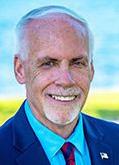
(R-Center Moriches) are paramount; as are New York State Assemblyman Fred Thiele (D-Sag Harbor) and Senator Monica Martinez (D-Brentwood), who both sponsored the legislation in their respective chambers. Additionally, Governor Kathy Hochul (D), who signed the bill into law on the state level, and our partners in the private sector including The Nature Conservancy, the Citizens Campaign for the Environment, the Building & Construction Trades Council of Nassau & Suffolk Counties, the Long Island Contractors Association, the Long Island Federation of Labor, and others.
A ‘yes’ vote on Proposition 2 means less pollution, improved water quality, continued open space acquisitions and an increase in solid, local jobs. A yes vote is good science, good economics, and good sense.
Legislator Kevin McCaffrey (R-Lindenhurst) has represented the Fourteenth District in the Suffolk County Legislature since 2014. The Fourteenth District includes Babylon Village, Gilgo-Oak Beach-Captree, Copiague, North Babylon, North Lindenhurst, and West Babylon.
Legislator McCaffrey has served as the Presiding Officer of the Legislature since 2022. The Fourteenth District office is located at 125C South Wellwood Avenue in Lindenhurst and can be reached at 631-854-1100.
Continued from front cover
“Suffolk County is the second-largest county in the country where Republicans are coming out to vote early and in person.” Garcia told supporters.
The early vote totals, which are tabulated by party registration, not the actual vote itself, across the country are often seen as a barometer for Election Day results. Democrats traditionally lead this category heavily, but Republicans currently lead early vote totals in Suffolk and in each of the premier presidential battleground states. The logic here is that if Republicans are ahead in early voting, then the Election Day product might be even more fortuitous for them.

“Seven days does not mean that we just sit on our laurels because we’re winning our early voting,” Garcia cautioned supporters, adding that “Democrats hire people to come in from the city to try to get their voters out.”
“Not us; we have you,” Garcia said to attendees, urging all to bring friends, family members, and community organizations to the polls to back Suffolk’s GOP team.
Garcia noted that, in just the last few years, Republicans flipped control of the County Legislature, which they had not controlled for sixteen years, the District Attorney’s office, which they had not controlled for twenty, and the County Executive’s office, which they had not controlled for twenty.
“How are our borders doing? How’s our economy doing? How’s inflation doing? How’s the world’s situation?” asked County Executive Ed Romaine (R-Center Moriches). “We need to change the course and direction of this country. And that’s why in the early voting, our party is leading. It offers hope and it offers change for a safer, more affordable world.”
Former Congressman and 2022 gubernatorial candidate Lee Zeldin (R-Shirley) attended the rally immediately after leaving a roundtable with former President Donald Trump (R-FL) in a suburb of Philadelphia. Zeldin said that he turned down an invite to rally with the President in Allentown, as there was “nowhere more important” for him to be than in Suffolk County for their annual get-out-the-vote (GOTV) Hangar Rally.
“There are a lot of people who didn’t vote for Donald Trump in 2016 and 2020, but they’re going to vote for him in 2024. They want the conservative solution to have safer streets. They want the Republican solution to be able to afford to survive, to have a secure border, to have a president who ends foreign wars instead of starting new ones. Now is the time for us to win over people who have never voted Republican in Suffolk ever before,” said Zeldin.
Zeldin gestured to a large American flag hanging behind the stage and candidates, saying, “That flag is our love of this country. It’s for our kids, our rule of law, whether it’s about parental rights, family, or values.”
The rally was also geared towards whipping support for President Trump, U.S. Senate Candidate Mike Sapraicone (R-Floral Park) pictured right, as well as Assembly challengers, Stephen Kiely (R-Mattituck) in the First District, Aamir Sultan (R-Dix Hills) in the Tenth, and Joe Cardinale (R-Amityville) in the Eleventh.
“I’ve been all over the state for the last eight months, and everywhere I go, nobody knows who she [Senator Kirsten Gillibrand (D)] is,” said Sapraicone. “That’s because she’s become a Washington politician who doesn’t care about us anymore.”

“We’ve got a fork in the road. To the left, is Kamala Harris (D-CA), open borders, and four more years of disastrous policies,” said Congressman Andrew Garbarino (R-Bayport). “The road to the right is lower inflation, secure borders, safer communities, getting our national respect back on the world stage, and President Trump and Republican policy.”
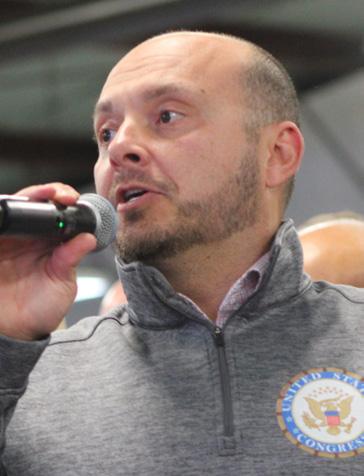
Garbarino pictured left reported that the travels of Speaker Mike Johnson (R, LA-04) reveal a level of support not seen for President Trump nationwide since 2016.
Senator Anthony Palumbo (R-New Suffolk) noted the differences between Trump and Harris, stating that Trump is a “businessman” who “loves this country,” while contrasting Harris has someone who “doesn’t love this country” and referenced her work in California and how it has “trickled down” to the current state of disrepair.
“That seems to be emblematic of what our parties have become,” said Palumbo. “We’re the party that cares about the future, not about handouts.”
Palumbo also stressed the importance of voting in local elections, as those elected officials often make the most differences in their constituents’ lives than others higher up on the ballot usually do.
“Think about what has happened since we [Republicans] lost the Senate in 2018.
Credit: Matt Meduri
Our state budget has increased by $78 billion and we have become the highest-taxed state in the nation since we became a one-party-rule state,” said Palumbo, adding his optimism that the party is likely to pick up enough seats to break the Senate supermajority.
Speaking for the Assembly delegation was Assemblyman Doug Smith (R-Holbrook), who is seeking his fourth full term this year.
“We did in 2016; we sent a strong message to Washington. We’ve sent that message to Albany. We’re here for the future, for our families, for our neighbors. We don’t want New York to continue being the greatest exporter of our friends and family,” said Smith. “This is what’s at stake; this is our ‘why,’” he added, referencing the prime impetus that leads many to take up elected office.

“We have communities who are failing. We have hardworking, tax-paying, middle-class families, who are having a hard time putting food on their table, keeping their lights on, while we are giving $5 billion to people who come over the border illegally, some of them for nefarious purposes, to come here to commit crimes,” said Assemblyman Ed Flood (R-Port Jefferson Station) pictured left. “The oneparty Democratic control makes sure we can’t even work with federal immigration officials to get people who have committed these heinous crimes out of our country.”
Flood added that Democratic opponents in key Suffolk races have changed their platforms to be in more line with the Republican message.
“They’re moving to the right because they know their policies don’t work,” said Flood. “They’re saying they’re against bail reform while the people backing their races are the ones who enacted it. They’re saying they want to bring tax relief to the people, but they’re in control of the purse strings.”
“What we have in Suffolk County is so rare: Good, hardworking, red-blooded, patriotic Americans willing to take time out of their own days to knock on doors, make phone calls, plant lawn signs to protect our awesome community,” said Congressman Nick LaLota (R, NY-01) pictured right “Two years ago, New York shocked the world when we flipped six [congressional] seats that President Biden carried just two years earlier.The nation is watching us. The nation cares about what happens on Long Island with these congressional districts. The nation is relying upon us to put this great country back on the right track.”
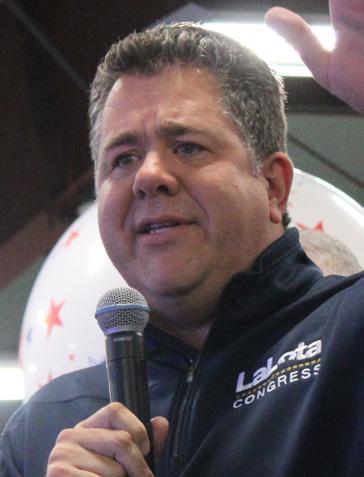
Assemblyman Michael Fitzpatrick (R-St. James) called Proposition One a “wolf in sheep’s clothing” and offered his assessment of the controversial referendum placed before New Yorkers this year.
“The language is intentionally vague to create an environment for lawsuits. There are people on the left who want to give illegal aliens taxpayer-funded benefits and the right to vote,” said Fitzpatrick, which he and many others believe will be facilitated by the proposition’s addition of “national origin” as a protected class, should the initiative pass.
“Parents will not have the ability to govern the raising of their children because Prop 1 will allow children to make these decisions without the input of their parents,” said Fitzpatrick. “It doesn’t mention abortion, but it mentions pregnancy, which means a lawsuit is going to be filed challenging Catholic hospitals to try and force them to do abortions.”
Fitzpatrick added that the legislation was crafted over two sessions in Albany, but Democrats intentionally put it on the ballot this year to ensure its passage with turnout concurrent to the presidential election. He asserted that Democrats’ championing of this bill as a ballot initiative puts responsibility on the voters and makes it much more difficult to reverse, as it will be a constitutional amendment if it passes.
All electeds and candidates hailed Chairman Garcia for his leadership over the last few cycles, asserting that “he only wins,” and thanking him for his support and tenacity in growing Suffolk’s Republican brand.
The well-attended rally, while a yearly tradition for the Suffolk GOP, served as a much more poignant picture for the direction of the state and nation that will be decided in just less than a week’s time.
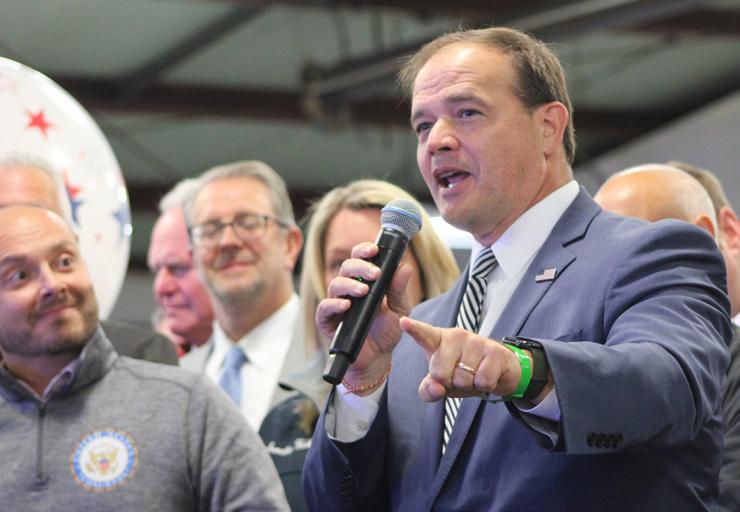
By Matt Meduri
National
In a final push to voters, Vice President Kamala Harris (D-CA) has capitalized on comments to call former President Donald Trump (R-FL) a “fascist” just days ahead of the crucial election.
Harris’ comments come off the heels of a New York Times interview with John Kelly, a retired Marine Corps General who served as Trump’s Chief of Staff from 2017 until 2019. In the interview, which was also published by The Atlantic, Kelly claims that Trump is, by definition, a “fascist,” and that the president suggested that Nazi leader Adolf Hitler “did some good things.”
When asked if Harris believed that Trump is a fascist, she replied, “Yes, I do.” She then doubled down on this belief, saying herself that if Trump were to be re-elected, he would be a “president who admires dictators and is a fascist.”
Kelly’s comments were described by the Vice President as a “911 call to the American people.”
Harris seizing on these comments is reminiscent, although not quite as incendiary, as Hillary Clinton’s (D-NY) famous “basket of deplorables” comment about Trump supporters in the closing weeks of the 2016 election. Some said, and still hold, that that comment was the nail in the coffin for her campaign.
President Joe Biden (D-DE) also took a swing at Trump’s supporters in the wake of the president’s Madison Square Garden rally on Sunday. Comedian Tony Hinchcliffe made a joke about Puerto Rico being a “floating island of garbage,” which was quickly denounced in unison by the media.
When asked about the comment, Biden replied, “The only garbage I see floating out there is his supporters. His demonization of Latinos is unconscionable, and it’s un-American. It’s totally contrary to everything we’ve done, everything we’ve been.”
A White House spokesperson clarified that Biden was referring to the “hateful rhetoric” as “garbage,” not Trump’s supporters.
Biden later personally clarified what he said on X, formerly known as Twitter.
“Earlier today I referred to the hateful rhetoric about Puerto Rico spewed by Trump’s supporters at his Madison Square Garden rally as garbage — which is the only word I can think of to describe it. His demonization of Latinos is unconscionable. That’s all I meant to say. The comments at that rally don’t reflect who we are as a nation.”
Senator Marco Rubio (R-FL) quickly denounced the comment: “Moments ago, Joe Biden stated that our supporters, our patriots, are garbage. He’s talking about everyday Americans who love their country.”
Even prominent Democrats distanced themselves from their tickets’ response to the joke. Governor Josh Shapiro (D-PA), who was seen as a frontrunner as Harris’ running mate, said that he would “never insult the good people of Pennsylvania or any Americans even if they chose to support a candidate that I didn’t support.”
President Trump held his historic rally at Madison Square Garden in the heart of New York City on Sunday evening (pictured top).
The Big Apple was the site of a most unexpected campaign stop from the Republican nominee, as New York State has not backed a Republican nominee since 1984. Not generally considered to be competitive this cycle, Trump and many others agree there’s a large amount of quiet support for him here.
The MSG rally was standing-room only within the venue, with many more outside watching on jumbotron televisions. Reports say that almost 250,000 people RSVP’d for the event.
The rally was also something of a homecoming for the former president, with his deep, lifelong ties to New York on full display as he came back to the city he once called home.
A long list of guests also greatly increased the rally’s energy. Congresswoman Elise Stefanik (R, NY21), Speaker of the House Mike Johnson (R, LA-04), Vice Presidential nominee Senator J.D. Vance (R-
who introduced her husband to the stage.
Lines wrapped around Eighth Avenue and ThirtyFourth Street, with the famed street entertainer, the Naked Cowboy (pictured right), serenading the diverse crowd of rally goers with his endorsement of Trump.



wrestling star Hulk Hogan, CEO of SpaceX and X, formerly known as Twitter, Elon Musk, television psychologist Dr. Phil McGraw, former Congresswoman Tulsi Gabbard (R, HI-02) - who recently registered as a Republican - former Independent presidential candidate Robert F. Kennedy, Jr., former presidential candidate Vivek Ramaswamy (R-OH), and former FOX News host Tucker Carlson were just a few on the list of star-studded speakers who entertained a packed house.
Supporters were also treated to a rare public appearance from former First Lady Melania Trump,
Trump utilized the historic venue to introduce a new promise to voters: tax credits for caregivers.

Trump also spoke kindly of Mayor Eric Adams (D), who defended Trump’s prerogative to have a rally in New York, despite New York Democrats lambasting the event before its inception.
Suffolk County Executive Ed Romaine (R-Center Moriches) recently unveiled the County’s new Early Voting and Training Center located at the Board of Elections in Yaphank.
The center will serve as a hub for early voting and training of poll inspectors, poll coordinators, and other essential election personnel.
Suffolk County is committed to ensuring secure elections in our communities. The opening of the Early Voting and Training Center and ongoing measures to provide the Board of Elections with the necessary resources and infrastructure signifies our long-term commitment to guaranteeing that our elections are protected,” said Romaine (pictured below)
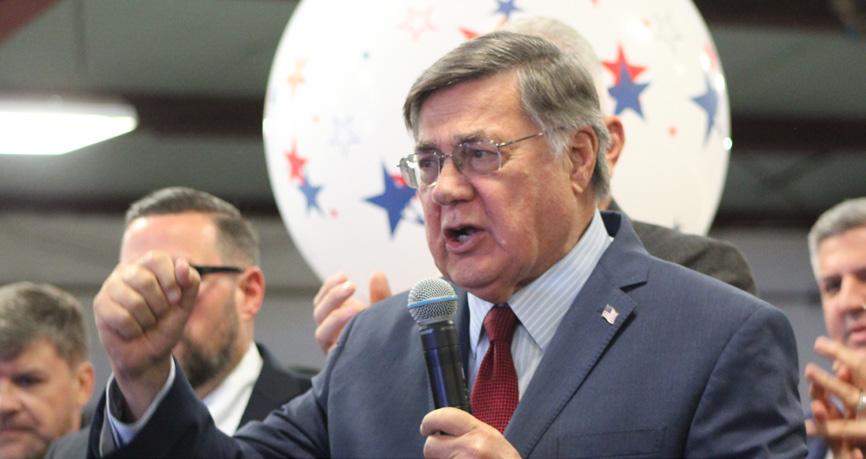
The $2.8 million center is part of the County’s ongoing investment into election infrastructure and security. The center is also equipped to deal with the even-year election law passed by Albany late last year, should the law be reinstated on appeal. It was recently knocked down as an unconstitutional oversight of home rule.
“Building this center is a crucial step in guaranteeing that all elections in Suffolk County are run with the highest levels of professionalism and integrity. We have established a state-of-theart Early Voting Center, centrally located and easily accessible from major thoroughfares for our voters,” said Suffolk County Board of Elections Republican Commissioner Betty Manzella.
“The construction of this early voting and training center will enable the Board to train hundreds of election workers annually with enhanced hands-on experience to facilitate a better voter experience for our residents,” said Democratic Commissioner John Alberts. The center will also serve as an early voting hub. Early voting began on October 26 and runs until Sunday, November 3. The center is one of twenty-eight early voting locations across the county. Residents can vote in any one of them, regardless of their residence. The H. Lee Dennison Building can also be used as an early voting site.
Few movements are of the construction and fiber of what Donald Trump has been able to muster since he came down the Trump Tower escalator in June 2015. His entrance into American politics has completely changed the name of the game, giving us three elections none of us have seen in our lifetimes, ushering in a period to which many in the media, including ourselves, colloquially refer as the “Trump Era.”
Of more focus on 2024, Trump has established perhaps the most diverse array of support for a major campaign in the modern era, not just down to his support in the streets, but among the people he plans to take with him to Washington should he be re-elected to a second nonconsecutive term. Trump’s teamwork with Robert F. Kennedy, Jr. is the closest this country has come to a fusion ticket in generations and vocal support from former Congresswoman Tulsi Gabbard, now a Republican, of Hawaii, certainly helps us see that even those with some progressive stances not only realize that the left has gone too far, but that those same concerned citizens have a seat at the Trump table.
Moreover, the Florida Republican’s assembly of a slate of individuals does not agree with him on every issue, which Mr. Trump himself has acknowledged, but they instead look forward to solving the issues on which they do agree and have made that their premier selling point. It’s a breath of fresh air in a highly divisive era of politics and it’s one that’s much more desirable than the “bipartisan slate” Vice President Kamala Harris has put together, which includes notable war hawks like Dick Cheney and John Boulton. It’s a tradeoff we here at The Messenger are more than okay with.
Regarding the top two issues on most voters’ minds on a perennial basis, safety and the economy, Mr. Trump has regularly polled ahead of Ms. Harris in terms of which candidate is better equipped to handle both. Our conversations with people on the ground in deep-blue Manhattan reveal a very broad, yet somewhat tacit, base of support for the former president on these issues. Our June 6 cover story documented conversations with New Yorkers outside of Trump Tower the day after the president was convicted on thirty-four felony


charges. We found that his support that day was not of an “old, white, angry” party, but a diverse coalition of people who mostly did not consider themselves Republicans. One gentleman spoke of the necessity to “learn finance” when Mr. Trump was president, due to finally being able to get ahead and make a living.
We also note Mr. Trump’s promises of no taxes on tips for service workers, no taxes on Social Security, and no taxes on overtime. The former president has also toyed with the idea of no federal income taxes at all and to return the country to an entirely tariff-based economy, one of which the country has not run in over a century. These are big promises, and ones we hope can and will be implemented. It’s now incumbent on Mr. Trump to deliver these promises, a process we’ll be watching closely.
Mr. Trump has also vowed to raise the cap on State and Local Tax (SALT) deductions that are so desperately needed here in New York. Although his 2017 legislation installed the $10,000 cap, Mr. Trump has signaled his intent to take a different approach to the deduction this year. With his future partners in Congress from Suffolk County, we believe that that is a highly feasible reality.
Mr. Trump’s ability to communicate with minority voters also signals that the Republican Party is changing, at least nationally, and for the better. Building a diverse coalition through which the public can air their grievances, which are mostly the same for the vast majority of Americans, is a step in the right direction for a major American political party, and one we look forward to seeing in action.
Finally, Mr. Trump has stumped in the Empire State three times this campaign. RFK spoke to Suffolk voters in May when he was still running as an Independent. Ms. Harris hasn’t given much of a message to New York, which isn’t much of a demerit considering the broad expectation that she will carry the state, but it makes our endorsement easier.
The Messenger endorses Trump.
New Yorkers can choose between two-term incumbent Senator Kirsten Gillibrand or go with a new face in Mike Sapraicone.
It’s difficult to see what Senator Gillibrand (D) has done for New York, much less Long Island. Moreover, it’s difficult to track any real presence from Gillibrand here, despite having a regional office in Melville. At least Senator Chuck Schumer (D) was present for two inaugurations here in January and his office is frequently in touch with state-level elected officials when needs arise.
Gillibrand’s absence and silence are deafening, and since winning a second full term in 2018, her crowning achievement seems to be running for president in 2020 amidst a crowded field. She didn’t have much to say then, which saw her rake in only paltry national support. Four years later, Gillibrand still doesn’t seem to have much to say. Her work on restoring the cash shortfall in the 9/11 First Responders’ fund is good work, but highly bipartisan, and a no-brainer project. We need more than that project to vouch for her.


Sapraicone is making his first full bid for office this year. The Floral Park Republican is a retired NYPD Detective and founder of Squad Security, a provider of “high-end corporate, technology, entertainment, and complex logistical

security services,” according to their website. Sapraicone rightly sees Senator Schumer’s differing political views along with his visibility and accessibility, identifying a future partner in Washington. He also recognizes that Gillibrand is simply MIA, to the point where she receives reflected credit from the weight Schumer can pull in Washington.
Additionally, Gillibrand is not exceptionally bipartisan. The Lugar Center’s Bipartisan Index tracks her as the sixty-first most bipartisan Senator in 2023. It’s not terrible, but it’s not great either, especially considering her apparent timidity with Long Island voters.
The Senate needs another voice of reason and balance, but more importantly, a state as significant as New York needs someone to redefine its voice in the upper chamber. If Schumer isn’t going anywhere this year, then he would be better complemented by someone who is visible across the state and would be a go-to point of contact for federal issues, as Gillibrand is decidedly not.
The Messenger endorses Sapraicone.

Since taking office less than two years ago, Congressman Nick LaLota has been a firm leader for Suffolk County in the U.S. House. Being a freshman in the House is usually difficult work, and representing the large swath of land that consists of eight of Suffolk’s ten towns is no easy feat. Yet, LaLota has brought back funding for each of them, far and above what other freshmen members of Congress are able to accomplish.
Notably, his $1.4 million for Smithtown’s much-needed waste-water solutions is a huge prize for a major part of his district. The funds are expected to help mitigate floodwaters from heavy rainfalls, which usually result in Main Street businesses dealing with flooded basements and the Nissequogue River receiving large doses of road runoff.
For Brookhaven, a recent notable achievement is $1.5 million for badlyneeded dredging and infrastructure improvements to the Port Jefferson Harbor, a major port of entry to Long Island and a massive economic hub of the north shore.
Island-wide, LaLota has admirably carried the torch from his predecessor Lee Zeldin (R-Shirley) in ensuring Plum Island remains undeveloped and receives protections in perpetuity.
He’s also been an incredibly valuable asset in making the conversation of State and Local Tax (SALT) deductions a national conversation. He and the other Long Island Republicans held up last year’s vote on the Speaker of the House to ensure they could find a partner sympathetic to that particular cause. He and his colleagues have formed a national coalition of other House members to bring this to the table next session. And if Donald Trump is elected president, LaLota will have another
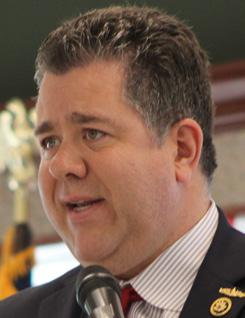
staunch ally in the fight to ensure we receive those deductions.
Moreover, LaLota has been a pragmatic conservative. His bipartisan work with other members have Congress have been a valuable asset to both our district and the country, as his work with others have seen bills and amendments pass the House, including, but not limited to, stopping the scourge of fentanyl and xylazine in our communities, protecting our Pine Barrens from invasive species, and working to ensure Veterans’, their services, and their families are cared for.
His opponent, John Avlon (D-Gramercy Park), touts his own records as having worked with Republicans and with the nonpartisan No Labels group. However, Avlon carefully toes party lines to hold the bottom line in a district that is likely to stick with a productive incumbent. Avlon is also yet another carpetbagger in the long series inflicted upon NY-01 over the last decade or so. He’s been intentionally vague about his residency, but The Messenger takes pride in being the first source in the nation to uncover his tax documents, revealing a much more intimate New York City habitation than advertised.
He’s knocked LaLota on his residency too. We hold that LaLota living just south of the border of a district in which he’s otherwise spent his whole life is fundamentally different from a Manhattanite who used his summer rental home as an anchor to claim residency. Only adding insult to injury is that Avlon’s Sag Harbor home is in one of the most affluent parts of the district, which isn’t a problem in and of itself, but becomes a major problem when he’s trying to represent a predominately working-class district.
The Messenger endorses LaLota.
Patchogue, Blue Point, East Patchogue, and Fire Island have been front-andcenter in conversations of water quality, coastal resiliency, and flooding, all issues that Jarett Gandolfo has taken to Albany with him since 2020, and will continue to for another two years, at least.
The Sayville Republican rightly notes that sewers are a “huge” priority, noting the need for sewer lines for Oakdale and Bayport. He was also a huge part of the crosswalk safety improvements in Sayville, something he hopes to bring to other downtowns across his district with more State funding.
He’s also attuned to the cost of living for families and childcare costs, a game in which he has significant skin, being a father to two young children. One

of his bills that he `introduced would regionalize median income eligibility for State childcare subsidies, an issue that, under the current eyes of the State, is unbalanced and does not accurately reflect exorbitant living costs faced here that are not experienced elsewhere in the state.
He’s also provided some commonsense changes to the state’s immigration laws, vis-à-vis “Laken’s Law,” a bill he sponsored earlier this year in response to the brutal murder of Lake Riley, a Georgia student killed by an illegal migrant who had first committed crimes in New York, for which he was released and for which federal authorities were not properly notified. His bill would have also revoked sanctuary status for
If the Fifth Assembly District had its own mayor, that title would undoubtedly go to Doug Smith.
Since his special election victory in 2018, the Holbrook Republican has not only been an effective leader in the minority, but also one that has elevated the near-universal working-class voice of his district, one that used to be a Democratic bastion not that long ago.
Smith sits as the highest-ranking Republican on the Education Committee, leveraging his years of teaching experience, coupled with his years of experience as an aide to his predecessor. Smith was one of the loudest voices against the proposed reduction in Foundation Aid to school districts, organizing a March rally at the H. Lee Dennison Building against the cuts. Smith has already met with Robert Megna, a budget guru heading the Rockefeller Institute of Government’s updates to the state’s formula for Foundation Aid. He’s already working on what could be another contention

budget season regarding the issue. Smith also proposes a new metric to evaluate a school district’s worthiness of state aid, namely as it relates to what constitutes a student as “successful.”
Smith also sits on screenings for Board of Regents nominees. Smith told us that some nominees “should be nowhere near making education policy,” proving to us that he’s a valuable opinion on who determines the metrics of educational success in our state.
Smith has also been a revered partner on the local level, including, but not limited to, ensuring the cleanup of Lake Ronkonkoma, the quality-of-life crimes for which law enforcement’s responses are stifled due to the bail reform laws, and the construction of a state-of-theart playground and community square in downtown Holbrook.
Smith’s opponent, Michael Reynolds (D-Lake Ronkonkoma), is actively campaigning, but made no appointment to screen with us for this race.
The Messenger endorses Smith.
New Yorkers should be excited about what Dean Murray has brought to the table and what he’ll continue to bring to Albany for another two years.
Murray has been an ardent supporter of commonsense laws in Albany, some of which Democrats have refused to take up. He’s been the leading voice on “Nick’s Law,” which would impose stricter penalties for hit-and-run drivers who leave the scene of an accident resulting in death or serious injury. He also proposed the commonsense foil of Nassau County’s ban on face coverings in public spaces. The East Patchogue Republican’s bill would still allow face coverings in public, even during political demonstrations or protests,
the State and New York City.
Gandolfo’s opponent, Garrett Petersen, has a wealth of experience as a clinician working with developmentally disabled individuals. He’s been a part of a study to help acclimate patients to real-life scenarios that might be stressful for those who are easily overstimulated or stressed by certain settings, such as a dentist’s office. His top priority is working to properly fund his current field of study, a worthy endeavor, but also essentially the end of his specific knowledge of his district.
Petersen also stated to us that the State and City’s sanctuary statuses do not need to be repealed, an issue with which we fully disagree with him.
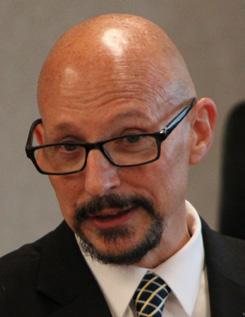
but would carry aggravated charges for crimes committed while wearing a mask, as well as introducing a new charge of Aggravated Concealment of Identity.
Murray has also helped shepherd Mastic Beach’s massive downtown revitalization through the halls of Albany, has been a prominent voice on much-needed changes to bail reform and the State’s drug laws, specifically as it relates to fentanyl and xylazine, has been working to ensure law enforcement are better equipped against drug-intoxicated drivers, and has been a consistent community presence.
Murray’s opponent, Michael Conroy (D), is not actively campaigning.
The Messenger endorses Murray.
Moreover, the East Islip Democrat’s view of politics in Albany is interesting, to say the least. He believes that the “perception” of New York government and politics is weak, and that Democrats have not been “leading as a party.” He criticizes Hochul’s indecisiveness and ineffectiveness as a leader, but also says that Long Island is “brainpoisoned” by New York Post headlines.
Petersen also gave credit to Gandolfo, saying he’s done a “great job” with the resources he’s been provided, but is effectively kneecapped by his role in the minority to get more than “what he needs” for his district. On the former point, we’re inclined to agree with him.
The Messenger endorses Gandolfo.
Anthony Palumbo had unenviably large shoes to fill in the wake of Ken LaValle’s retirement in 2020. His transition from the Assembly to the Senate has been a smooth one, as he’s been one of the most productive members of the delegation. Of his more than fifty bills that pass the chambers, the lion’s share have been signed by the Governor. His Community House Fund (CHF) plan is a step in the right direction in keeping the housing markets balanced, while also allowing municipalities to retain their home rule. He’s carried on LaValle’s age-old tradition of the “Environmental Roundtable,” a gathering of notable East End stakeholders to discuss needs and problems of the environment.
Palumbo, a Republican of New Suffolk, was also a hero for New York in suing the Senate Judiciary Committee for a floor vote for Hector LaSalle, Hochul’s nominee for the Court of Appeals. LaSalle’s rejection without a vote was unprecedented in modern history, and while he ultimately was not confirmed, Palumbo ensured that that strike was called.
Most recently, Palumbo introduced
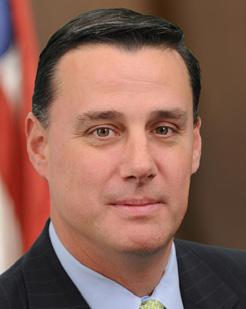
legislation to combat reckless drivers who intentionally seek out the quiet streets of Suffolk for donuts and burnouts. Quality-of-life issues are important to him, and it shows.
His opponent, former six-term County Legislator Sarah Anker, brings legislative experience to the table, but we don’t feel she can match Palumbo’s understanding of his entire district. The Mount Sinai Democrat also never screened with The Messenger, making it even more difficult for us to understand her positions.
Anker is also currently under investigation by the County Legislature for allegedly removing and/or destroying documents before she left her office last year. It’s certainly a demerit, but it’s something that needs to pan out in the horseshoe before we can fully make a judgment call there.
The investigation notwithstanding, we’d still find Senator Palumbo worthy of another term. We’re hopeful he continues to bring his common sense conservatism and judicial watchdog attitude to Albany. Our state can surely use it.
The Messenger endorses Palumbo.
After just two terms in Albany, Jodi Giglio has certainly left her mark.
Her biggest fight is that of benefits for those with intellectual and developmental disabilities. Perhaps her biggest win was that of a limited real property tax exemption for disabled individuals, a bill that passed unanimously last year. The Baiting Hollow Republican is also aware of the calamitous mudslides in Rocky Point after the remnants of Ernesto battered the north shore in August, positing that the State should

evaluate maintenance schedules of wastewater systems to better hold up against extreme weather events in the future.
Giglio has also helped direct money into her district’s services, such as the libraries of Riverhead and Baiting Hollow, while also ensuring that her district retains its bucolic, rural-suburban feel.
Giglio’s opponent, Tricia Chiaramonte (D-Manorville), is not actively campaigning.
The Messenger endorses Giglio.
Joe DeStefano is running for his fourth term in the Assembly. The Medford Republican also serves as a Medford Fire District Commissioner and volunteer firefighter. As such, his role in Albany has been crucial in advocating on half of law enforcement, first responders, and EMS. One of his bills that was passed recognized 911 operators as first responders, a commonsense move that we, and clearly others in Albany, agree with.
DeStefano told us that while he’s not a “Green New Deal guy,” he’s
Two years ago, Ed Flood sent political shockwaves through the county in ousting veteran incumbent Steve Englebright.
This year, Fourth District voters have two options: a one-term Flood, or former Port Jefferson Village Trustee and Deputy Mayor Rebecca Kassay. Both are good options and both screened with The Messenger to make our decision easier.
Kassay has an education in environmental studies and is the proprietor of the Fox and the Owl bedand-breakfast. Her time as a village trustee has afforded her experience in hyper-local government and has given her some name recognition among other local electeds.
Kassay calls for oversight on topdown spending from Albany. We don’t disagree, but Flood has already drafted a bill to divide the state into regional councils to better mitigate the effects of unfunded mandates and defeat a onesize-fits-all policy on numerous issues. In our screening, Flood used school language textbooks as an example, wherein some communities might need more textbooks of different languages, and less of others. In Albany’s eyes, all school districts must purchase and provide a standard set. Both candidates essentially call for the same issue, but Flood is more specific and has already worked towards making that a reality.
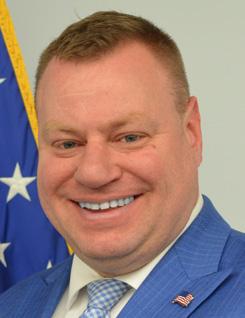
Flood has also helped bring to the table Gabby’s Law, which would create “Teal” Alerts - similar to Silver and Amber alerts - for missing individuals with mental health problems. It’s named after Blue Point’s own Gabby Petito, whose disappearance and death made national headlines. He also helped develop Melanie’s Law, which would allow orders of protection to pass to members of a household, even if those members are adults.
Locally, Flood hosted the first Human Trafficking Seminar at Stony Brook in August. It’s an important issue that requires intervention from all local levels, and we’re glad to see Flood call a meeting with dozens of community stakeholders to discuss how the issue can be combated at home.
Flood also fought to restore his district’s foundation aid funding, which resulted in accolades from school superintendents, and he delivered crucial funding for the Gordon Heights Fire Department.
While Flood’s disbarment is jarring, we hold that the circumstances are dubious enough to give him the benefit of the doubt. Moreover, Flood’s productivity for an upscale, purple district leads us to believe he’s worthy for another term. His big-picture ideas also make us hopeful to see what else he can come up with.
The Messenger endorses Flood.
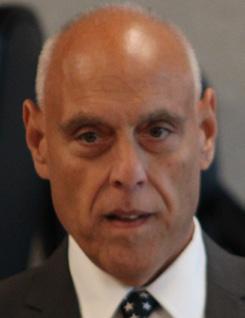
on the side of renewable energy, but not without making sure the markets and the public are ready. His bipartisanship also brings added value, as he not only represents a district with more registered Democrats than Republicans, but also because it demonstrates his ability to legislate above his own accolades and party lines.
DeStefano’s opponent, Trina Miles (D-Mastic Beach), is not actively campaigning.
The Messenger endorses DeStefano.
Andrew Garbarino had immensely large shoes to fill with the retirement of Peter King (R-Seaford) in 2020. Since then, however, Garbarino has fit into the role well and continually proves why he is worthy of the office.
Garbarino, a Republican of Bayport, has been able to bring back almost $100 million in funding for local projects, like sewers for downtowns like Patchogue and North Bellport. He played a pivotal role in halving the $3 billion shortfall that was supposed to hit the 9/11 First Responders’ healthcare fund. His prerogative in cybersecurity is a needed one, as the U.S. continues to be a national target, and Garbarino needs no more homework than what happened here in Suffolk to help safeguard our nation against a similar attack.
Garbarino is also a leader in climate solutions, namely as it relates to natural gas, hydrogen, and nuclear power. He’s worked bipartisanly to help meet the surging energy demands across his district and the country. He also provides pragmatic solutions to the migrant crisis, such as reinstating the Remain-inMexico policy, making the border more physically and technologically secure, and overhauling the asylum program to facilitate faster court hearings.
Garbarino offers a good defense of his vote in favor of President Biden’s infrastructure package, a vote for which

he received quick criticism from voters at home. His logic, with which we agree, is that since New York’s governance has robbed us of the infrastructure upgrades we’ve needed. Voting for the federal package was a way to bring home our tax dollars when Hochul has been “terrible” on roads, according to the Congressman, and when Cuomo wasn’t interested in having talks on sewers during his tenure. Moreover, Garbarino’s creed that he makes the votes best for his district, but not necessarily for politics, is one we respect and wish there was more of in our legislative institutions.
Garbarino’s opponent, Rob Lubin, 29, is making his run for public office. The Lindenhurst Democrat is impassioned in the fight against lower-cost prescription drugs, as he suffers from a rare condition that took his vision in his left eye and deals with the effects of costly medication. We’re not sure his plan for a price cap will be the best plan, but we sense his passion and earnestness on this issue.
While Lubin is certainly wellintentioned, we feel that Garbarino offers much more in terms of specificities and already has the job down well after just four years in office. Lubin might be more suited for an advisory role on prescription drug costs, but we don’t feel he’s ready for Congress.
The Messenger endorses Garbarino.
Thursday, October 31, 2024
By Matt Meduri
Election season is when we hear two phrases that carry somewhat esoteric meanings: “margin of error” being the first, and “tipping-point state” being the second. In our final Civics 101 column before the 2024 elections, we’ll discuss what these terms mean and how they relate to prognosticating and analyzing election results.
The margin of error is simply a metric for determining the confidence of a statistical study. In election season, this is a crucial standpoint of any poll conducted. It essentially expresses the possible sampling errors when a survey is performed randomly among respondents. The higher the margin of error, the less confidence one should have in the result of the study. The lower the margin of error, the more confident one can be in the survey’s results.
Margins of error are also used to showcase how accurately the information of the poll can be distributed among the general public without having to poll every single member of the public.
The exact margin is presented in a plus-orminus fashion (stylized as +/-). Margins of error also depend on what type of statistical study is employed to prove a hypothesis. In polling, the sample means is more binary, in that a person is either voting or not voting for a candidate for office. The confidence interval can vary based on these studies, but most polling is done with a 95% confidence interval. Shortly, this means that if a survey with a margin of error of +/three percentage points is fielded one hundred times, then the study would be expected to be true of the entire population 95% of the time, within three points of the result of the poll.
Take, for instance, the latest InsiderAdvantage poll of the presidential race in Wisconsin. The poll of 800 likely voters was conducted from October 26 to 27 and gives former President Donald Trump (R-FL) a onepoint lead over Vice President Kamala Harris (D-CA). When we dig a little deeper, we find that the margin of error is +/- 3.46%. This essentially means that the result could be 3.46% off from the one-point lead for Trump, in either direction. It could mean Trump is ahead by closer to five points, or it could mean that Harris is ahead by a bit more than two. Simply adding or subtracting the margin of error from the result of the poll is a decent benchmark for figuring out who exactly has the upper hand.
Currently, the swing states are all polling within the margin of error, for the most part. This means that it’s virtually impossible to know who is winning and in what states. With high confidence intervals, we could assume that the polling is reliable enough to track the end results in these critical states to a fairly accurate result.
The type of voter sampled and the overall sample size are two important aspects of election polling. Generally, polls that sample “likely” voters - stylized as “LV” on polling sitesare seen as more accurate than those that sample “registered voters” - stylized as “RV.” The logic here is that likely voters are the ones who are simply more likely to turn out on Election Day and, therefore, are the more reliable basket of voters to poll for the state of a race.
Registered voters are generally seen as more unreliable sources because simply being a registered voter does not guarantee political participation, nor does it guarantee those voters will stick with their registered party. Polls of RVs can be valuable, however, in
benchmarking a party’s support among the active rank-and-file in a certain race or state. If done correctly, these polls can help campaigns sound the alarm in states or districts where typical party support might be bleeding.
The figure of the “tipping-point state” is used by some election analysts as a way of figuring out which state was responsible for putting a presidential candidate over the magic number of 270 electoral votes. The tipping-point state is determined by ordering a list of states won by the victor from the largest margins of victory to their lowest margins. The state that puts the candidate over 270, with the winner’s margin in that state considered with respect to the winner’s margins of victory in other states, is considered the “tipping-point state.”
We’ll use 2016 as an example. Trump’s largest margin of victory on the statewide level was in West Virginia, where he earned 68.50% of the vote. This was followed by Wyoming, 68.17%, Oklahoma, 65.32%, and North Dakota, 62.96%. The list would continue, ordering Trump’s margins of victory in each state from a position of greatest-to-least. Simultaneously, these states’ electoral votes can be added to Trump’s column. The list would continue until it reached Pennsylvania, where Trump’s margin of victory was just 0.7%. However, relative to the states he won by greater margins, Pennsylvania is the one that put him over the top, making it the tipping-point state of the 2016 election.
The same can be done for Biden’s win in 2020. Biden’s greatest margin was in the District of Columbia, where he received 92.15% of the vote, followed by Vermont with 66.09%, and Massachusetts with 65.60%. This list continues until we reach Wisconsin, where Biden won by just 0.6%. With its ten electoral votes, and with other stronger margins behind it, Wisconsin was the tipping-point state in 2020.
What Will the Tipping-Point State be in 2024?
Both campaigns seem to agree that Pennsylvania is the must-win state for either of them. There are paths to victory for Harris without Georgia, Arizona, and North Carolina, and Trump could reclaim the White House without Nevada, Michigan, or New Hampshire. But Pennsylvania seems to be the key in this election, and virtually all of the major outlets, election prognosticators, and betting market savants all seem to have come to the same agreement.
But even with this in mind, it’s hard to tell if Pennsylvania will be 2024’s tipping-point state. If Trump’s win is bigger than expected, the tippingpoint state could be Michigan or Nevada. The same scenario for Harris could find Arizona or Georgia as the tipping-point states. The logic here is one with which some find issue with the tipping-point state model. The tipping-point state model assumes that margins across all fifty states and D.C. are, more or less, relative to one another, in that, if a big enough swing captures the whole country, then states are likely to statistically move in that direction based on their margins of victory for the candidate. If either candidate were to win Pennsylvania by a ten-point margin - a large unlikelihood for either campaign - it could indicate a relative swing in other states, effectively meaning that Pennsylvania would still be “tipping-point,” but
DARKEST STATES (New York/Alabama) - >10%
MEDIUM STATES (Minnesota/Texas) - 5-9%
LIGHT STATES (Michigan/Florida) - 1-4%
PALE STATES (Georgia) - <1%
This column will seek to address the long-forgotten concept of civics and how it relates to American government in general, from the federal level to the local level. This column will explore Constitutional rights, the inner workings of government, the electoral process, and the obligations and privileges of citizens.

that the election overall wouldn’t be remotely close. This isn’t an exact science, which makes trying to predict which state will be the tippingpoint especially difficult.
It also doesn’t account for policy positions or extenuating circumstances within a state’s political landscape that could shift it right out of contention for that spot. To use a ten-point margin in Pennsylvania as an example again, such a swing could be self-contained, in that it wouldn’t translate to a nationwide swing in the direction Pennsylvania chooses. This means that it could still be a close election, but the tipping-point state would be one of the several other possible suspects.
For trivia purposes, the last time New York was considered the tipping-point state was in
1944, when Franklin D. Roosevelt (D-NY) defeated Thomas Dewey (R-NY) for his fourth and final consecutive term. New York was the tippingpoint state three consecutive elections in a row: 1880, 1884, and 1888, the longest consecutive streak for any state to earn this distinction.
Colorado was the tipping-point state in both 2008 and 2012. Tennessee was Bill Clinton’s (D-AR) tipping-point state in 1992, and Michigan was Ronald Reagan’s (R-CA) in his forty-nine-state sweep in 1984.
The smallest state to ever earn this achievement is Rhode Island in 1920. Then at just five electoral votes - now at four - Warren Harding (R-OH) carried the state by 31.2%, but he won a national landslide, thereby proving the relativity of the tipping-point state statistic.



Assemblyman Fred Thiele (D-Sag Harbor) is finally retiring after representing the East End in Albany since 1995. Voters have two good options: Southampton Town Councilman Tommy John Schiavoni and Shelter Island Town Attorney Stephen Kiely.
Kiely, a Mattituck Republican, has twenty years of experience working as an attorney for the county’s smallest town and has a practical understanding of how laws are and should be written.
Schiavoni, a Sag Harbor Democrat, has served on the Southampton Town Council since 2017, and he has years of experience on multiple local boards as well. Schiavoni brings understanding of the South Fork’s geography and the precarious environmental situation in which the region finds itself.
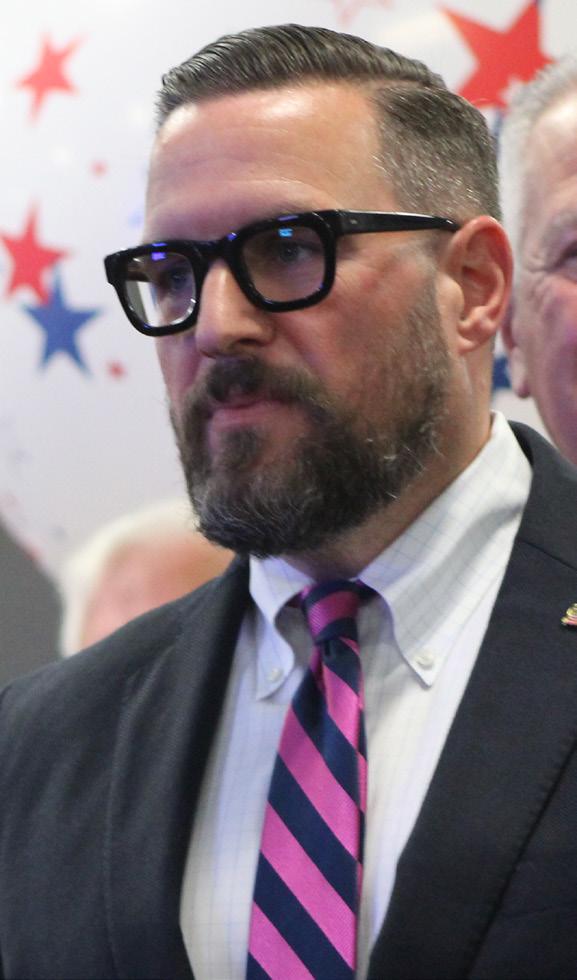

The district contains the entire townships of East Hampton, Riverhead, Shelter Island, Southold, and most of Southampton, but the Brookhaven communities of Eastport, East Moriches, Center Moriches, and Moriches as well.
The deciding factor here is local control. Schiavoni seems warm to the idea of the State having a role in helping municipalities increase their housing supplies, while Kiely sees little to no role for the State in the process. We don’t think some help from the State is unwarranted, but we stand by the principle of “Local control, not Hochul control.”
The Messenger endorses Kiely.
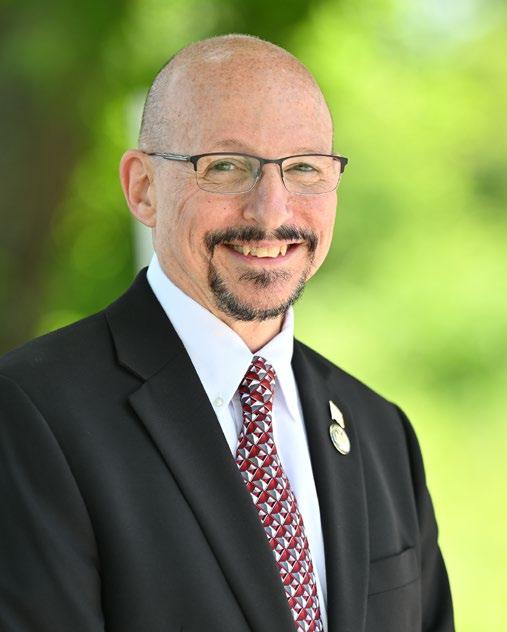


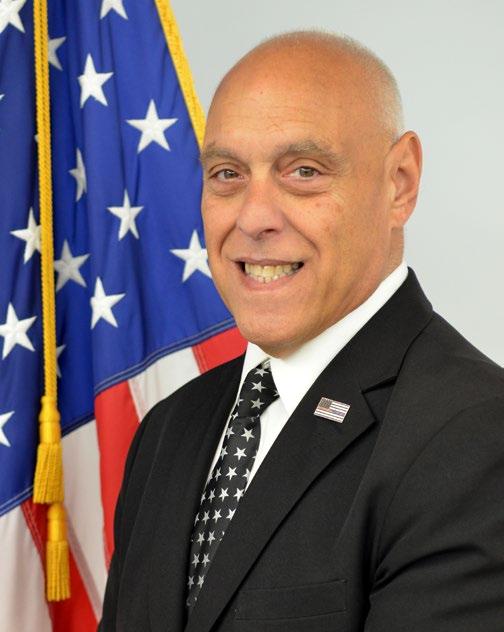


By Matt Meduri
While Hurricane Helene swept the Southeast, small mountain towns in Appalachia received perhaps the worst dose of the natural disaster out of any other part of the country. Not only is the mountainous terrain already unequipped for handling the heavy, uninterrupted rainfall, but the dams failed as well, literally erasing entire towns, buildings, and roads from the map.
The response and recovery efforts have shown the magnanimity of nonprofits, business owners, and other organizations, including, but not limited to, a caravan of pack mules being led through the mountains to deliver supplies and aid to areas inaccessible due to damage and landslides.
Smithtown decided to pitch in to deliver supplies to the communities reeling with total devastation and loss, to the tune of a fifty-three-foot tractor trailer, full of food, water, toiletries, warm clothing, blankets, grills, tents, pet supplies, livestock feed, firestarter logs, and carbon monoxide detectors, along with other non-perishables to help the people through the winter as they remain in shelters or otherwise displaced.

The trailer was donated by Westbury Trailer Leasing and Repair and headed down to North Carolina over the weekend, set to be unloaded at the Burnsville Baptist Church. The goods will be sorted and transported to Avery Airfield in Spruce Pine, about fifty miles northeast of Asheville. Goods will be distributed to the worst-hit areas in Asheville, Burnsville, Swannanoa, Black Mountain, and Chimney Rock.
Once the goods make it to Avery Airfield, boots on the ground will start the distributions. The process is being coordinated by Chad Caton, a Veterans for Trump surrogate who is originally from the affected area. Caton’s team of Veterans will coordinate with Heal-Corp, a critical medical support and humanitarian aid 501(c)(3) nonprofit, to fly the supplies to the devastated mountain communities.
Logistics of the deliveries are being orchestrated by Dawn Bond for the transport of the goods to North Caroline and Kevin Smith of the Long Island Loud Majority (pictured below right) for boots-on-the-ground coordination.

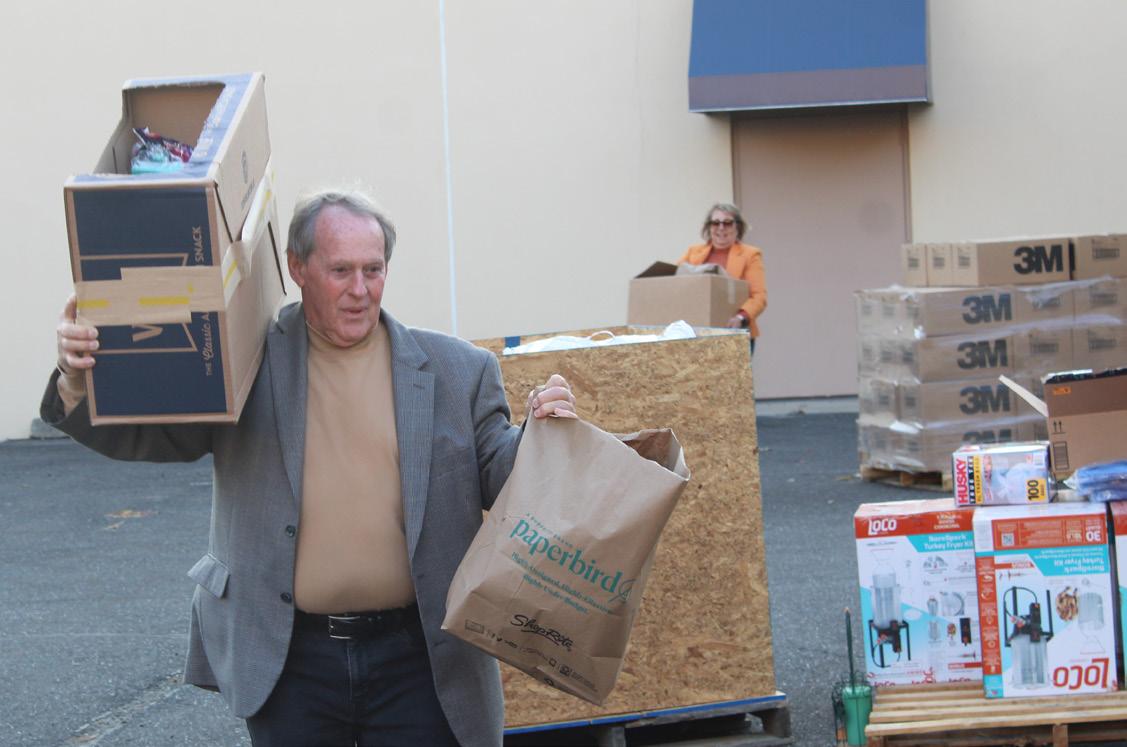
Heal-Corp is a team of experienced disaster relief personnel and former Army Green Berets who specialize in coordinating these types of rescue efforts and immediate relief provisions through temporary shelters, essential supplies, and field hospitals.
The trailer was packed last Thursday night at the Plumbers Local 200 headquarters in Ronkonkoma. Along with the union labor, elected officials also helped pack the truck, including Smithtown Supervisor Ed Wehrheim (R-Kings Park) (pictured above) , Assemblyman Michael Fitzpatrick (R-St. James), Assemblyman Ed Flood (R-Port Jefferson) pictured left, and Senator Mario Mattera (R-St. James) pictured below, whose long career with the plumbers’ union facilitated the humanitarian group effort.
“Plumbers Local 200 cares about people in need and that’s what we do,” said Mattera of his union, as well as the Nassau-Suffolk building trades. Mattera likened the disaster to Long Island’s own Superstorm Sandy in terms of devastating impact and a long-winded recovery effort.

“We’re Plumbers Local 200; we care and we’re here volunteering our time to make sure that the people in North Carolina receive any kinds of supplies that are necessary for them to survive,” said Mattera. “Being part of a union, we’re about solidarity. North Carolina, we are here for you to make sure you are taken care of.”
Mattera was joined by Rich Brooks, Local 200 business manager, Joe Squicciarini, business agent, Ed Tedla, organizer.
“It was a privilege to spend the evening helping out with Local 200, their apprentices, and the Nassau-Suffolk trades,” Supervisor Wehrheim told The Messenger
“They are some of the most selfless, generous people, and they did not disappoint. I also need to thank Debbie Virga, of the Commack School District, and the Commack Fire Department, who packed five huge wooden boxes loaded with emergency supplies. We know better than most how difficult these next few months, and honestly, years, are going to be for the people of North Carolina. It’s easy to forget when the news has moved on, but the truth is that these people need help now more than ever. I’m grateful we got to be a part of something together that will undoubtedly make a big difference to those who literally have lost everything.”
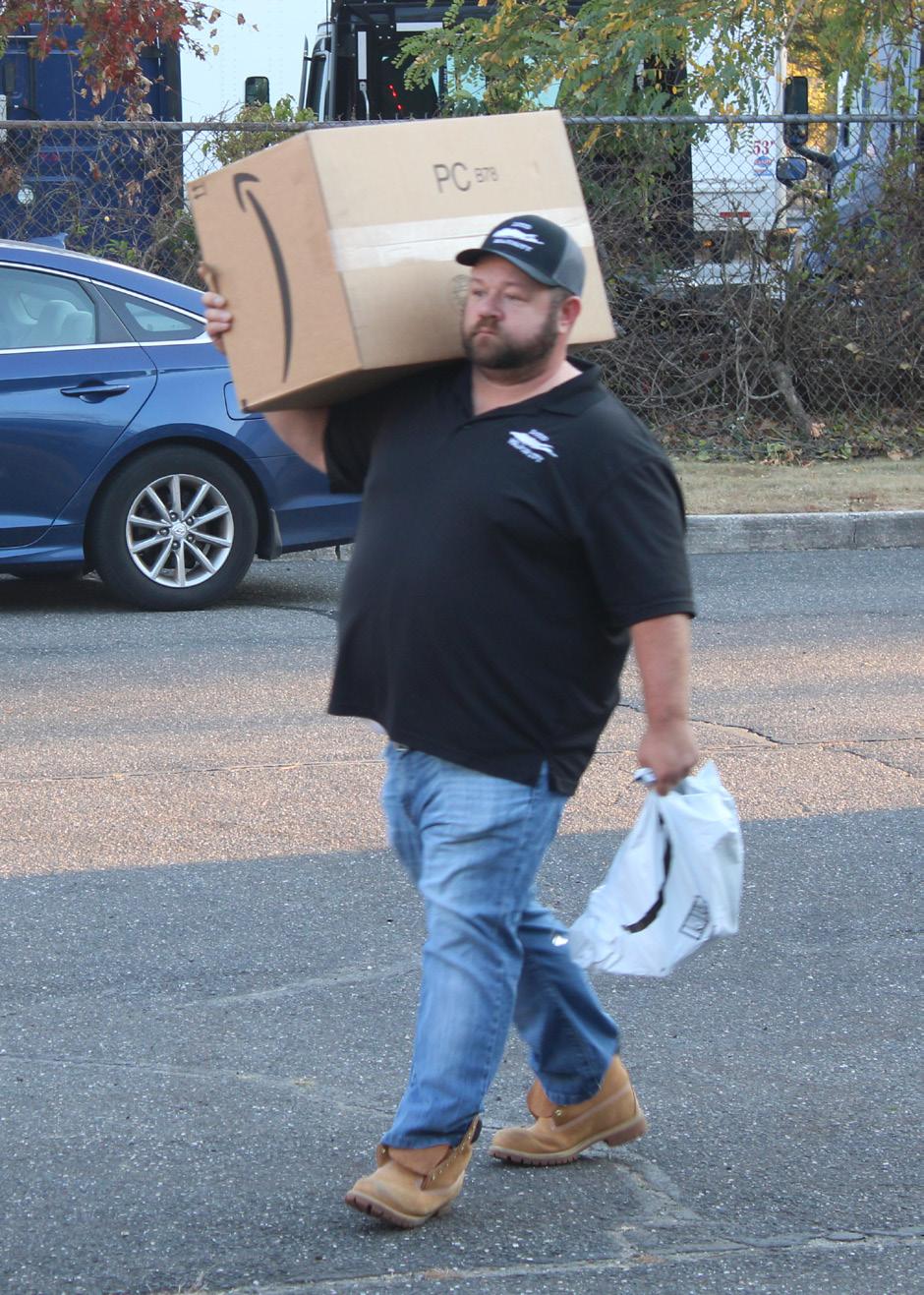
Fighting out-of-control spending to protect hard-working taxpayers!
Supporting Law Enforcement with proper safeguards and funding to keep our families safe!
Fighting rampant giveaways to illegal immigrants!
Opposing radical criminal justice “reforms”!
Advocating for a rebranded SUNY system as University of New York!
Protecting families. Protecting parental rights.
Protecting women’s sports!
Vote NO on Proposition One!
Endorsed by the Building and Construction Trades Council of Nassau & Suffolk, the National Federation of Independent Businesses, the Business Council of New York State, and the Long Island Gasoline Retailers Association
Official Candidate of the Republican and Conservative Parties

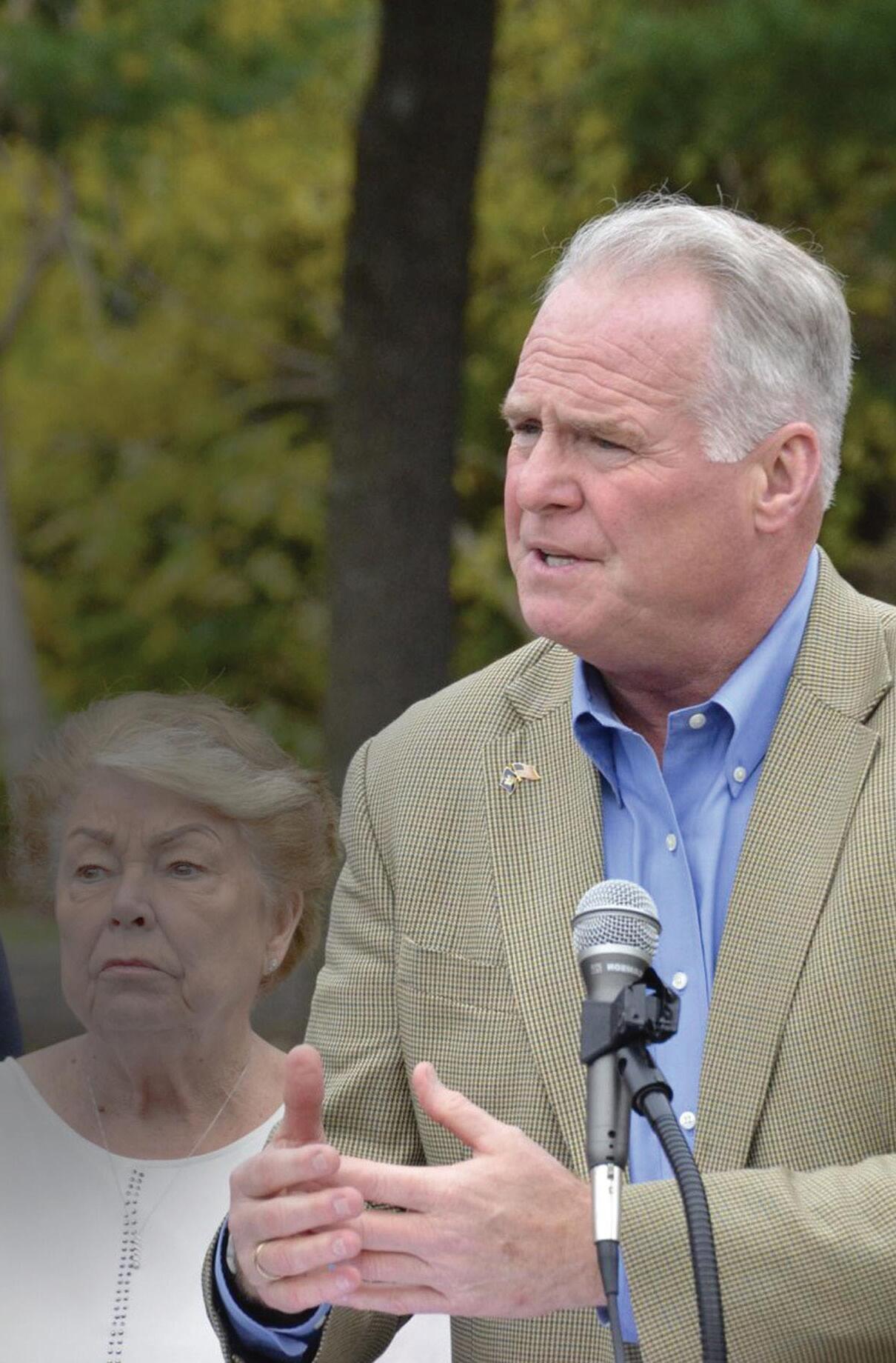
By Natalia Mittelstadt | AMAC Outside Contributor
Three states led by Republicans have gone on the offensive against the Biden administration by suing the Department of Homeland Security (DHS) over access to information to verify the citizenship status of registered voters. So far, the Biden/Harris White House is stonewalling the efforts at maintaining voter integrity.
While the Biden administration is suing states and towns across the country in an effort to thwart election integrity measures ahead of the presidential election, the states of Ohio, Florida, and Texas are going on the offensive by suing DHS in an effort to gain access to a database to identify non-citizens on voter rolls.
The Department of Justice has sued both Alabama and Virginia for attempting to remove non-citizens from their voter rolls less than 90 days before the election. However, as Ohio, Florida, and Texas are maintaining their voter rolls, the states filed lawsuits against DHS to further identify and remove non-citizens from voter registration lists.
DHS refuses to cooperate
Federal law only allows U.S. citizens to vote in federal elections, which all three states noted in their lawsuits against DHS. Ohio Secretary of State Frank LaRose (R) sued DHS on Thursday, alleging that the agency has stonewalled his efforts to find and remove noncitizens from his state’s voter rolls.
The lawsuit alleges that DHS refused to provide Ohio access to federal citizenship verification records to identify non-citizens on its voter rolls on at least four different occasions.
LaRose first asked DHS Secretary Alejandro Mayorkas in July “for access to federal databases and search tools, including the Person Centric Query Service (‘PCQS’), to ensure that Ohio could verify the citizenship of specific registered voters whose citizenship may be the subject of dispute,” according to the lawsuit.
Ohio uses DHS’s Systematic Alien Verification for Entitlements (SAVE) database, which allows non-citizens to be identified by “specific immigration identification numbers (like an Alien Registration Number) that States like Ohio rarely possess,” the lawsuit states.
However, “PCQS draws from a much broader array of identification information, making it far easier for State officials to confirm citizenship status without having to use one of those unique immigration identifiers that States rarely possess,” the lawsuit reads.
“I swore an oath to uphold our state constitution, and that document clearly requires that only United States citizens can participate in Ohio elections,” LaRose said in a statement on Thursday. “The Biden-Harris Administration is engaging in obstruction and outright abuse of power to prevent us from removing noncitizens from our voter rolls. I take my duty seriously, so if they want a fight over the integrity of our elections, they’ve got it.”
“While the administration is blocking access to these records, the Department of Justice is suing or threatening to sue multiple states, including Ohio, who are trying to enforce their citizenship voting requirements,” he added. “It’s hardly a coincidence. The same administration that’s presided over the most reckless, porous immigration policy in our country’s history is also intentionally blocking states from protecting the integrity of their elections.”
In September, House Judiciary Committee Chairman Jim Jordan, R-Ohio, sent a letter to Mayorkas demanding information about why the DHS had not complied with LaRose’s requests to get federal citizenship information.
Earlier this month, sixteen attorneys general, led by Ohio Attorney General Dave Yost (R) and South Carolina Attorney General Alan Wilson (R), called on Mayorkas to provide federal citizenship verification records for voter registration verification.
“[T]he Department of Homeland Security is required to coordinate with States to verify voter registration information upon request,” the letter reads. “This federal-state cooperation is mandatory—not optional.”
Arkansas, Florida, Georgia, Indiana, Iowa, Kansas, Montana, Nebraska, Oklahoma, South Dakota, Texas, Utah, West Virginia, and Wyoming joined the letter.
Ohio has identified and indicted non-citizen voters in recent months. Last week, six of the nearly 140 people referred to by LaRose for illegal voting were indicted for voter fraud.
Five of the indictments involved legal U.S. permanent residents without citizenship. The sixth involved a non-citizen who was accused of voting in 2014, 2016, and 2018. Only two of the indictments involved the 2020 election.
In May, LaRose directed all 88 counties to begin a removal process for non-citizens on Ohio’s voter rolls following a review by his office’s Public Integrity Division and Office of Data Analytics and Archives. The review analyzed data from the Ohio Bureau of Motor Vehicles and found 137 voter registrations of non-citizens who had twice confirmed their lack of U.S. citizenship. In August, LaRose directed county election officials Thursday to remove another 499 non-citizens registered to vote from the state’s voter rolls.
Prior to Ohio’s lawsuit, Florida sued DHS two days after the letter was sent from the 16 attorneys general to Mayorkas.
The state argues in the lawsuit that the Florida Department of State (FDOS) “identified a number of individuals for whom FDOS had evidence of non-citizenship but could not run a search on the SAVE database because FDOS does not have unique immigration identifiers for these individuals.”
Feds refuse to verify citizenship for voting
DHS allegedly denied Florida’s request for federal citizenship verification records, according to the lawsuit. However, the agency
is “obligated” under federal law “to provide that information to Florida,” the lawsuit states.
Meanwhile, Texas sued DHS last week, after attempting to get the agency to verify the citizenship of approximately 450,000 voters.
DHS allegedly refused the state’s request for information, which Texas argues is in violation of federal law.
“The Biden-Harris Administration has refused to comply with federal law, presenting yet another obstacle for Texas to overcome in ensuring free and fair elections in our state,” Texas Attorney General Ken Paxton (R) said in a statement. “The law demands that they provide important information regarding the citizenship of nearly half a million potentially ineligible voters. Since the Biden-Harris Administration has chosen to ignore the law, I will see them in court.”
DHS told Just the News on Tuesday: “DHS does not comment on pending litigation. More broadly, USCIS has engaged with Florida, Ohio, and Texas, and will continue to correspond with them directly through official channels. U.S. Citizenship and Immigration Services (USCIS) administers an online
Overview - AMAC -
The Association of Mature American Citizens
The Association of Mature American Citizens represents Americans 50 plus. AMAC is centered on American values, freedom of the individual, free speech, and exercise of religion, equality of opportunity, sanctity of life, rule of law, and love of family, with benefits at all levels.
AMAC plays a vital role in helping build the services that will enrich the lives of America’s seniors. AMAC Action, a 501 (C)(4) advocates for issues important to AMAC’s membership on Capitol Hill and locally through grassroots activism. To Learn more, visit amac.us
information service called SAVE that allows registered and authorized agencies, including election authorities in states, to verify certain individuals’ citizenship or immigration status.
“SAVE is the most secure and efficient way to verify an individual’s citizenship or immigration status, including for verification regarding voter registration and/ or voter list maintenance. By inputting an individual’s name, unique DHS-issued immigration identifier, and birthdate, registered agencies can determine whether that person has obtained U.S. citizenship through the naturalization process or, for certain other individuals born abroad, whether USCIS has information confirming their U.S. citizenship.
“Federal law prohibits non-U.S. citizens from registering and voting in Federal elections; violators are removable and face up to five years in prison.”
In August, Texas Gov. Greg Abbott (R) announced that more than 1 million ineligible voters have been removed from voter rolls since 2021. Of those, more than 6,500 non-citizens were found, and about 1,930 of them have voted nonetheless. The records of those 1,930 voters were being sent to Paxton’s office from the secretary of state’s office for investigation.














October 31, 2024
Origin:
The noun “upset” comes from the Middle English words up- and set, meaning “raised up”. The earliest known use of the word was in the Middle English period, around 1150–1500.
Synonyms: shocker, rout, toppling
Noun
Pronounced: uhp·set
Definition: an unexpected result or situation, especially in sports competitions or election results.
Example: “The ousting of the career politician was considered the greatest political upset of the night.”
Antonyms: lose, yield, preserve status quo
Source: Oxford Languages


E K R B A C
See how many words you can create. Must have center letter in word and can use letters more than once. 4 letter word minimum.


See bottom left for the answers (please don’t cheat!)

November 6, 1860: Republican Abraham Lincoln of Illinois elected the 16th President of the United States

November 1, 1997: “Titanic” directed by James Cameron, starring Leonardo DiCaprio and Kate Winslet premieres at the Tokyo International Film Festival (Academy Awards Best Picture 1998)
November 4, 1845: First nationally observed uniform election day in the United States, the first Tuesday after the first Monday in November

November 2, 1936: At 3:00p.m. the BBC begins the world’s first regular highdefinition TV broadcast service from specially constructed studios at Alexandra Palace, North London

November 5, 1979: Supreme Leader of Iran Ayatollah Khomeini describes the United States as “The Great Satan” amid accusations of imperialism and the sponsoring of corruption
November 3, 1906: International Radiotelegraph Conference in Berlin selects “SOS” (· · · – – – · · ·) distress signal as the worldwide standard for help

October 31, 1517: Martin Luther sends his Ninety-five Theses to Albert of Brandenburg, Archbishop of Mainz, precipitating the Protestant Reformation
Since it was unveiled by Albany lawmakers, Proposition One has received a regular dosage of criticism nearly every day on the campaign trail. Disguised as a way for New Yorkers to enshrine certain “rights” for a myriad of protected classes, we find that it is nothing more than what many have aptly described it as: “a wolf in sheep’s clothing.”
It’s no secret that New York has been hailed as a sanctuary for abortions and that the rights extended to residents here surpass those offered to residents of other states. If that’s the case, then why the ardent push to further codify said “rights” for which we are a beacon on a hill?
Thus begins the fundamental problem with Proposition One. We understand that legalese can be burdensome and more protections for certain classes and/or services might need protection, but this seems entirely counterintuitive from the messaging we’ve seen in New York, especially in a post-Roe v. Wade environment.
Furthermore, the proposition’s vague language speaks to its evident construction by a lawyer. The two-paragraph proposal lists new protected classes, should the initiative become part of the State Constitution: ethnicity, national origin, age, disability, creed, religion, or sex, including sexual orientation, gender identity, gender expression, pregnancy, pregnancy outcomes, and reproductive healthcare and autonomy.”
We find these metrics to be intensely subjective and we can only imagine the litigation that will ensue based on current laws, standing, and precedent of other protected classes in New York, namely as it pertains
to applicants of Title IX of the Education Amendments Act of 1972, which prohibits sex discrimination in educational programs that receive federal subsidies.
In short, it creates an entirely new environment in which we’re unsure if those already protected by laws like Title IX would remain protected. Moreover, it seems as if the amendment would start a fierce legal debate over which protected class’ rights end and where another’s begin. The subjectivity of gender expression and identity is another that can easily grow out of proportion, with there being no protection from those who wish to usurp the vague language to their own gain by simply “identifying” as someone from a newfound protected class.
The biggest bait-and-switch aspect of this proposition is that it’s being advertised as an abortion-rights failsafe, yet the word “abortion” is not mentioned once, only the oddly hazy “pregnancy” and “pregnancy outcomes.” New York has some of the most lax abortion laws in the country. With such overarching protections already in existence and with no indication those protections will fade any time soon, it seems redundant to add these measures to the constitution in a measure that’s already a hodgepodge of other stipulations.
Overall, we find Proposition One to be nothing more than a big lollipop for the state’s most progressive voters, one that will inevitably be a Pandora’s Box of litigation and whose intentionally ambiguous language will likely create more problems than it seeks to solve.
The Messenger endorses a “No” vote on Proposition One.
Proposition Two might not be as debated as Proposition One, but it certainly has generated plenty of conversation with Suffolk circles.
Proposition Two is the Suffolk County Water Quality Restoration Act, which, if passed, would institute a one-eighthcent sales tax increase to help fund wastewater solutions across the county, which includes sewering of vulnerable and downtown areas and Innovative Alternative Wastewater (I/A) Systems in areas where sewers cannot be installed but the environment nonetheless needs that type of mitigation.
This bill was intended for last year’s ballot, but Republicans in the Suffolk County Legislature recessed the vote, claiming they disapproved of the ratios between sales tax funds for sewers and I/A systems - a 75%-15% split, with 10% for administrative costs, in favor of I/A systems, where the remaining 15% was essentially up in the air as far as earmarks were concerned.
Republicans made good on their promise to return the initiative to the ballot this year, this time with a more comfortable 50%-50% arrangement between sewers and I/As.
The process has been more bipartisan than not, with a wide variety of stakeholders lobbying for this policy for the better part of a decade. Moreover, the bill was shepherded through Albany by Assemblyman Fred Thiele (D-Sag Harbor) and Senator Monica Martinez (D-Brentwood), with plenty of Republican counterparts signing on to put this referendum in front of voters.
County Executive Ed Romaine (R-Center Moriches) signed the bill over the summer, marking the penultimate step in the process. The final step is either passage or failure of the amendment on Election Day.
Proponents argue that the one-eighthcent sales tax is necessary to bring Suffolk County into the Twenty-First Century. This is a fair assessment, as our water infrastructure is critically lagging behind other highly populous areas of the country, and as the nation’s most populous suburban county, we don’t have an excuse. Furthermore, sewers are the lifeline of any downtown, and our downtowns, from Kings Park to Oakdale to Mastic Beach, all urgently require revitalizations in order to create a better, self-sustaining economy here in Suffolk. Heightened water quality initiatives can
host a wider array of hospitality and entertainment and be a boon to housing projects that are needed to cool the market and allow younger residents to stay in Suffolk.
Opponents of the idea say that the County already has enough in reserves to start massive implementation now and that another tax is not what the bipartisan slate of its backers ran on. The two Hauppauge holdouts are Legislator Leslie Kennedy (R-Nesconset) and Rob Trotta (R-Fort Salonga). They were the only two Legislators to vote against putting this referendum on the ballot, citing their constituents’ opposition to another tax. Trotta, even since last year, has been especially critical of former County Executive Steve Bellone (D-West Babylon) and other previous administrations from bilking taxpayerapproved sales tax increases to fund water quality restoration.
We can respect their diligence in representing their constituents accurately, and we can also agree that this county has learned the same history lesson time and time again by instituting these increases, just to find ourselves in the same problem we had forty years ago.
It’s what makes this a hard call for us. We can easily say that all legislators, those in Hauppauge or Albany, Republican or Democrat, are not at all opposed to water quality restoration efforts. They certainly recognize the need, but in the cases of Legislators Kennedy and Trotta, their grievances are more with the logistics and historical lack of transparency than anything else.
On the other hand, we understand how pressing of a concern water quality remediation is in Suffolk. We also firmly believe that as long Executive Romaine and the incumbent Legislature are overseeing the slight tax increase and ensuing projects, should the initiative pass on Tuesday, then the funds will end up in their required destination. What happens after Romaine and company leave office is what makes us somewhat concerned that we could have a repeat of history on our hands.
Overall, there are good points to be made on either side, and we can’t dock anyone for voting for or against this measure. We’ll leave this one up to the voters.
The Messenger takes no stance on Proposition Two.


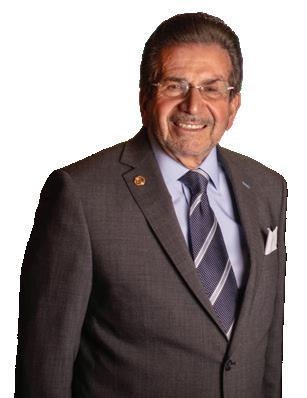




















By Ashley Pavlakis
The Commack High School Boys Cross Country team is continuing its competitive culture this season, a culture that’s been cultivated for decades. The boys are currently 5-0-0 in a league where every school has a chance to win.
The Commack Cougars are led by head coach Paul Sleavensky, who is in his twenty-eighth year as a coach at the school. Sleavensky is joined by assistant coach Ed Boll. The veteran head coach was named coach of the year in League, County, and Division categories during the 2023 season.
“It’s been great, we have a great program. My predecessor developed a program thirty years ago and we worked well together. I try to keep up the tradition he established years ago,” Sleavensky told The Messenger
Sleavensky took the Cougars to five invitationals this season to help prepare his team for what’s to come down the road.
“Invitationals you get to choose where you wanna go. We chose a few different invitationals this year based on what we want to try and get out of it. Sunken Meadow is a course where you need a time to get to the division meet and a time for the state qualifier on November 6,” said Sleavensky. “We wanted to run that course at least once to get a time to qualify. The Queensbury invitational we went to [where the state meets will be held], we went there just to take a look at the course. Last year we were fortunate enough to get to the state meet as a team for the first time and we didn’t get a chance to run on the course, it was a little bit of a disadvantage. We didn’t know exactly how challenging it really was.”

while others might go individually. The Cougars are most successful as a pack.
“We try to emphasize running as a group throughout the whole course. That’s a goal of ours, to run as a pack. We want to try and get our time faster throughout the course each time we run it. We want to work on winning the league championship every year, get to the division meet, and possibly win that. We’re always looking to be productive and competitive each season,”
The Cougars run in a pack, stressing the importance of having each runner play a role in the overall score.
“Depending on the race we try to be in the top groups finishing the race, if not possibly winning it. We want to run as a team because in cross country it’s not the best runner, it’s the team. You have to have five athletes scoring for you, if you have a low score then you win the meet,” said Sleavensky.
Cross Country is a strategic sport. Coaches look at their team and make a decision based on the strengths their team possesses. Some may choose to run as a group,
The Cougar head coach keeps his team motivated throughout the season with end goals in mind from start to finish.
“Last year our mantra was ‘we weren’t done yet’. We were underestimated last year, we were the underdogs. We won a lot of races last year and we won a lot of invitationals,” said Sleavensky. “This year, Suffolk County has a lot of great teams and it’s extremely competitive. We didn’t get a fast start this year but I told the boys ‘It’s not how you start, it’s how you finish’. We may start slow at the beginning of the season but we’re going to finish strong. They’ve been working really hard these past few weeks.”

The U.S. Surface Transportation Board (STB) has approved the Townline Rail application for a 5,000-foot rail line onto the CarlsonCorp property in Kings Park.
During a thorough Environmental Assessment, the STB addressed questions and concerns raised by residents. Unfortunately, misinformation continues to circulate in the community. You can read the STB’s full environmental findings by scanning the QR Code below.
HazMat Because the Town of Smithtown and the State DEC have jurisdiction over the transloading facility and will not permit hazardous materials to be transloaded at the facility, materials such as chlorine, petroleum products, or other hazardous chemicals will not be transloaded on or off of rail cars coming in and out of Townline Rail.
Hours of Operation Loading and unloading of material will take place under our permitted hours of operation Monday through Saturday with one train per day in and out; this will not be a 24/7 facility.
Truck Traffic Transportation of sand, gravel, and other materials to the industries along Old Northport Road by rail reduces truck traffic into the area from other locations. Shipping ash and construction debris off Long Island by rail significantly reduces truck traffic on our major highways.
Environment The STB’s analysis states that with mitigation measures that we have agreed to, there will be minimal to no adverse environmental impacts (EA at pg. iii) and “no impacts on groundwater.” (EA at pg. 50)
Zoning The Town of Smithtown updated Master Plan acknowledges the history of Old Northport Road as an industrial corridor which contributes to the local economy and states this area is not for residential development.

The best option for the future





